UNIT 43 TAPPING INTO NEW AND INTERNATIONAL MARKETING: A Case Study of Derwent & Sons Stationery
VerifiedAdded on 2024/06/10
|23
|4421
|166
AI Summary
This report examines the global business environment and its implications for SMEs, specifically focusing on Derwent & Sons Stationery, a UK-based company seeking to expand into South Africa and South Asia. The report analyzes the PESTLE factors, SWOT analysis, and various international market entry strategies, including direct sales, distribution, joint ventures, and developing local leadership. It also explores the advantages and disadvantages of importing and exporting, as well as the impact of tariff and non-tariff barriers. The report concludes with recommendations for Derwent & Sons to effectively tap into international markets and achieve sustainable growth.
Contribute Materials
Your contribution can guide someone’s learning journey. Share your
documents today.
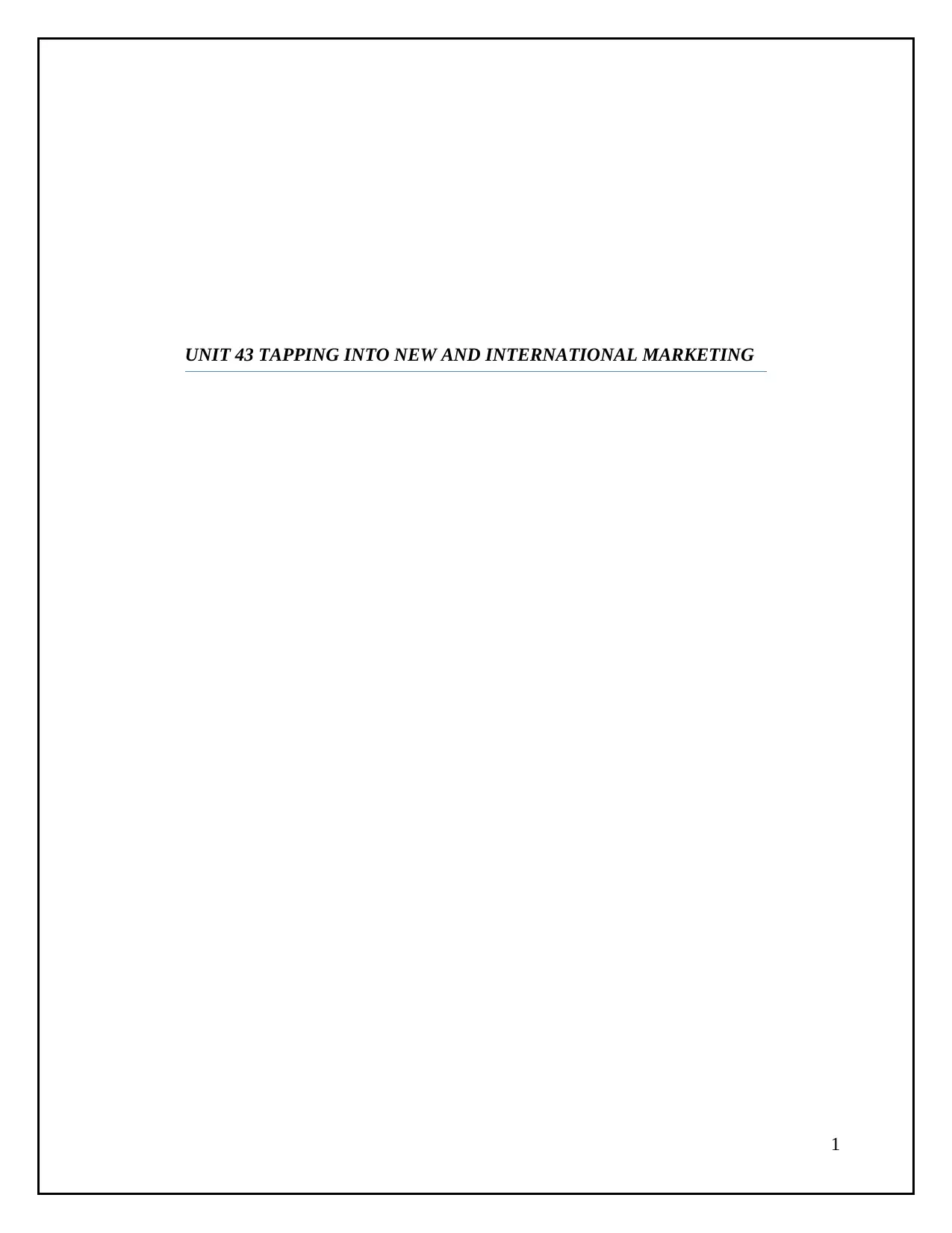
UNIT 43 TAPPING INTO NEW AND INTERNATIONAL MARKETING
1
1
Secure Best Marks with AI Grader
Need help grading? Try our AI Grader for instant feedback on your assignments.
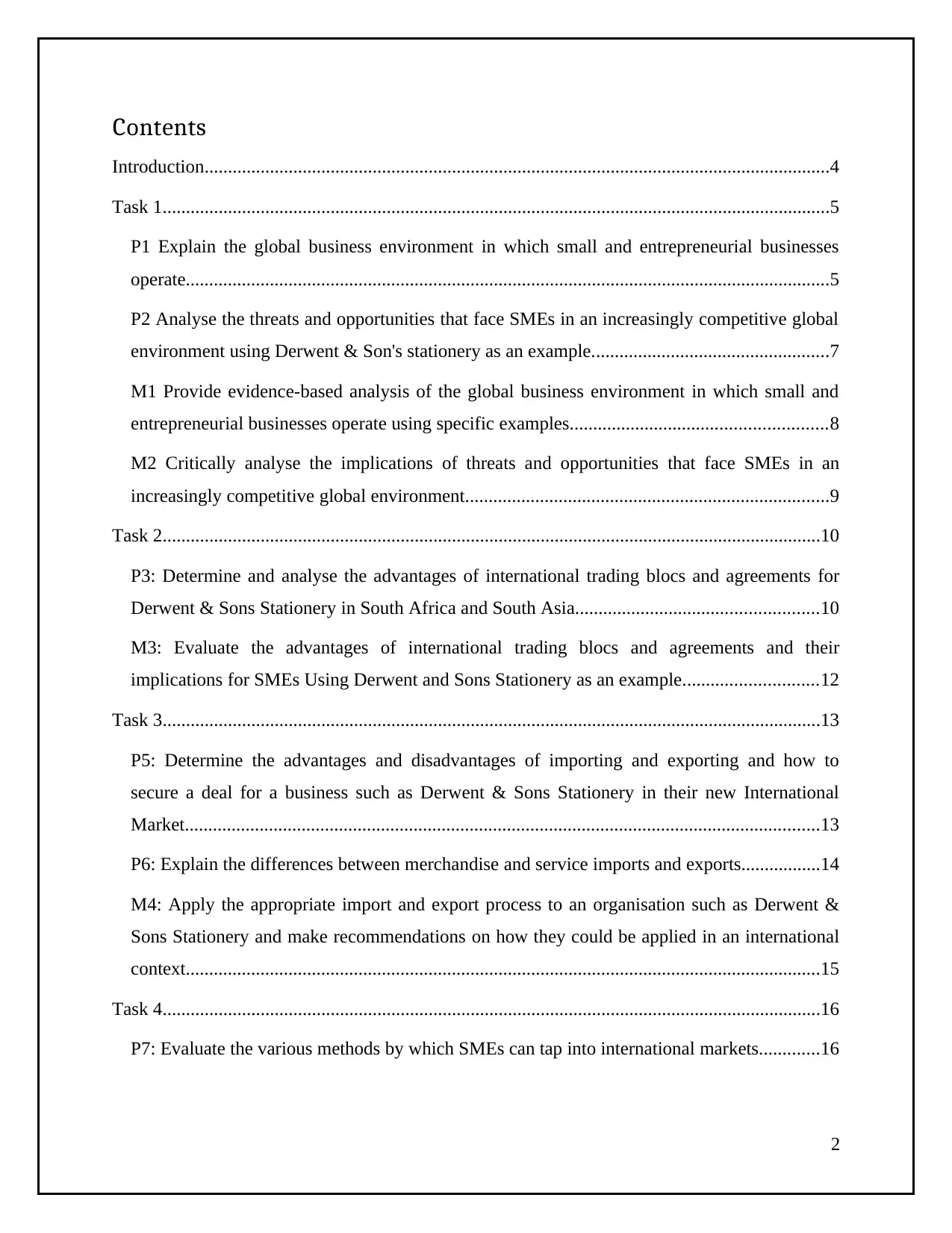
Contents
Introduction......................................................................................................................................4
Task 1...............................................................................................................................................5
P1 Explain the global business environment in which small and entrepreneurial businesses
operate..........................................................................................................................................5
P2 Analyse the threats and opportunities that face SMEs in an increasingly competitive global
environment using Derwent & Son's stationery as an example...................................................7
M1 Provide evidence-based analysis of the global business environment in which small and
entrepreneurial businesses operate using specific examples.......................................................8
M2 Critically analyse the implications of threats and opportunities that face SMEs in an
increasingly competitive global environment..............................................................................9
Task 2.............................................................................................................................................10
P3: Determine and analyse the advantages of international trading blocs and agreements for
Derwent & Sons Stationery in South Africa and South Asia....................................................10
M3: Evaluate the advantages of international trading blocs and agreements and their
implications for SMEs Using Derwent and Sons Stationery as an example.............................12
Task 3.............................................................................................................................................13
P5: Determine the advantages and disadvantages of importing and exporting and how to
secure a deal for a business such as Derwent & Sons Stationery in their new International
Market........................................................................................................................................13
P6: Explain the differences between merchandise and service imports and exports.................14
M4: Apply the appropriate import and export process to an organisation such as Derwent &
Sons Stationery and make recommendations on how they could be applied in an international
context........................................................................................................................................15
Task 4.............................................................................................................................................16
P7: Evaluate the various methods by which SMEs can tap into international markets.............16
2
Introduction......................................................................................................................................4
Task 1...............................................................................................................................................5
P1 Explain the global business environment in which small and entrepreneurial businesses
operate..........................................................................................................................................5
P2 Analyse the threats and opportunities that face SMEs in an increasingly competitive global
environment using Derwent & Son's stationery as an example...................................................7
M1 Provide evidence-based analysis of the global business environment in which small and
entrepreneurial businesses operate using specific examples.......................................................8
M2 Critically analyse the implications of threats and opportunities that face SMEs in an
increasingly competitive global environment..............................................................................9
Task 2.............................................................................................................................................10
P3: Determine and analyse the advantages of international trading blocs and agreements for
Derwent & Sons Stationery in South Africa and South Asia....................................................10
M3: Evaluate the advantages of international trading blocs and agreements and their
implications for SMEs Using Derwent and Sons Stationery as an example.............................12
Task 3.............................................................................................................................................13
P5: Determine the advantages and disadvantages of importing and exporting and how to
secure a deal for a business such as Derwent & Sons Stationery in their new International
Market........................................................................................................................................13
P6: Explain the differences between merchandise and service imports and exports.................14
M4: Apply the appropriate import and export process to an organisation such as Derwent &
Sons Stationery and make recommendations on how they could be applied in an international
context........................................................................................................................................15
Task 4.............................................................................................................................................16
P7: Evaluate the various methods by which SMEs can tap into international markets.............16
2
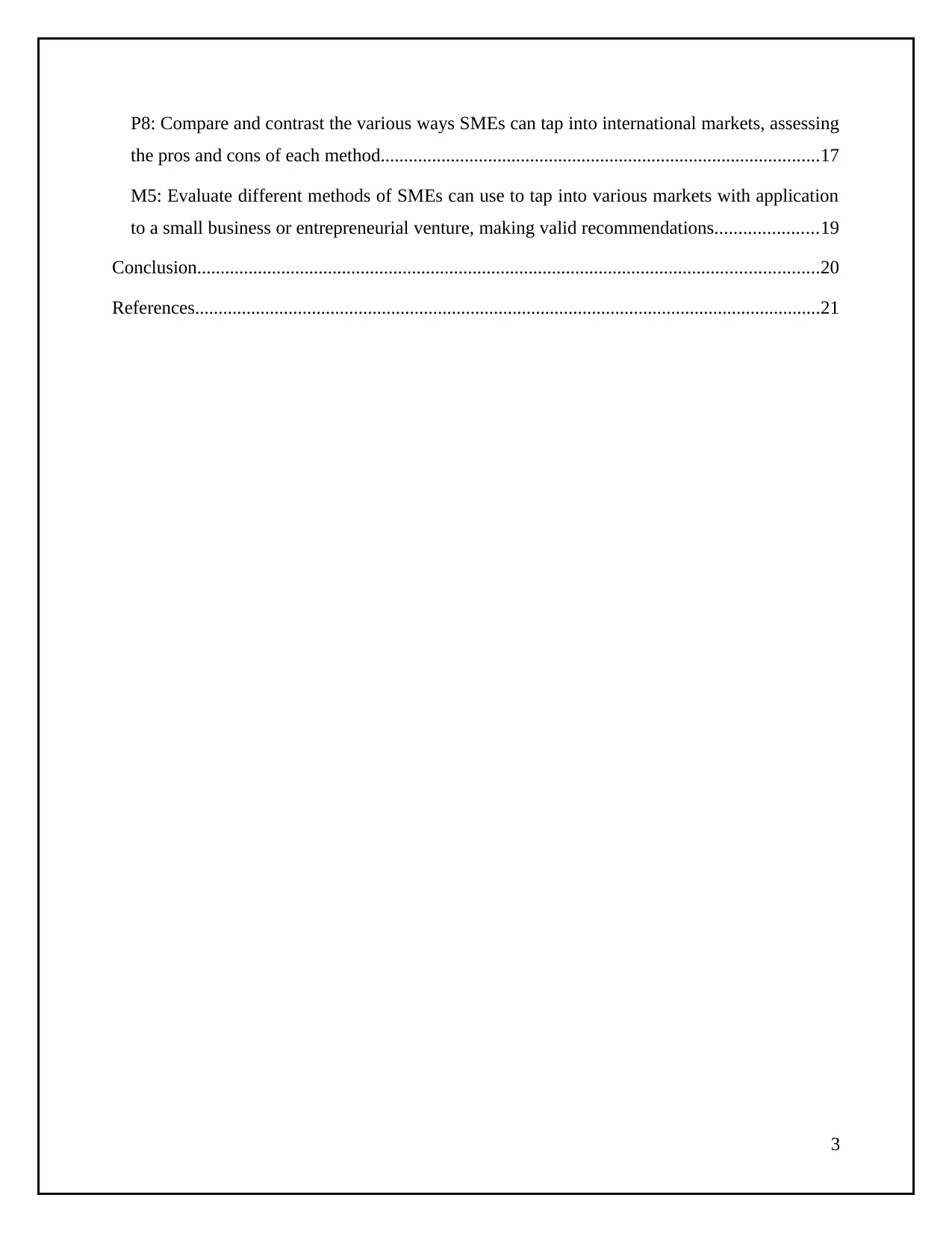
P8: Compare and contrast the various ways SMEs can tap into international markets, assessing
the pros and cons of each method..............................................................................................17
M5: Evaluate different methods of SMEs can use to tap into various markets with application
to a small business or entrepreneurial venture, making valid recommendations......................19
Conclusion.....................................................................................................................................20
References......................................................................................................................................21
3
the pros and cons of each method..............................................................................................17
M5: Evaluate different methods of SMEs can use to tap into various markets with application
to a small business or entrepreneurial venture, making valid recommendations......................19
Conclusion.....................................................................................................................................20
References......................................................................................................................................21
3
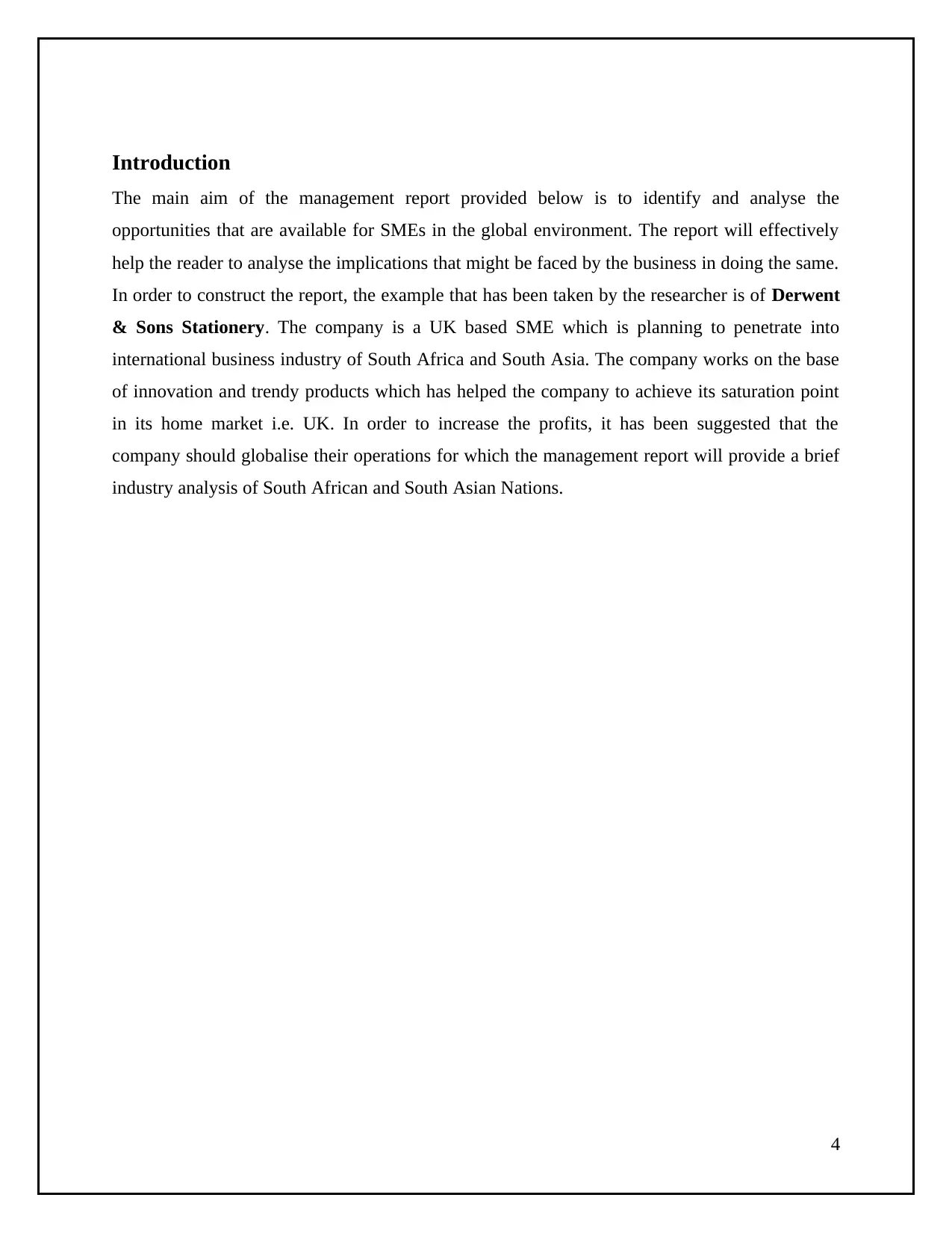
Introduction
The main aim of the management report provided below is to identify and analyse the
opportunities that are available for SMEs in the global environment. The report will effectively
help the reader to analyse the implications that might be faced by the business in doing the same.
In order to construct the report, the example that has been taken by the researcher is of Derwent
& Sons Stationery. The company is a UK based SME which is planning to penetrate into
international business industry of South Africa and South Asia. The company works on the base
of innovation and trendy products which has helped the company to achieve its saturation point
in its home market i.e. UK. In order to increase the profits, it has been suggested that the
company should globalise their operations for which the management report will provide a brief
industry analysis of South African and South Asian Nations.
4
The main aim of the management report provided below is to identify and analyse the
opportunities that are available for SMEs in the global environment. The report will effectively
help the reader to analyse the implications that might be faced by the business in doing the same.
In order to construct the report, the example that has been taken by the researcher is of Derwent
& Sons Stationery. The company is a UK based SME which is planning to penetrate into
international business industry of South Africa and South Asia. The company works on the base
of innovation and trendy products which has helped the company to achieve its saturation point
in its home market i.e. UK. In order to increase the profits, it has been suggested that the
company should globalise their operations for which the management report will provide a brief
industry analysis of South African and South Asian Nations.
4
Secure Best Marks with AI Grader
Need help grading? Try our AI Grader for instant feedback on your assignments.
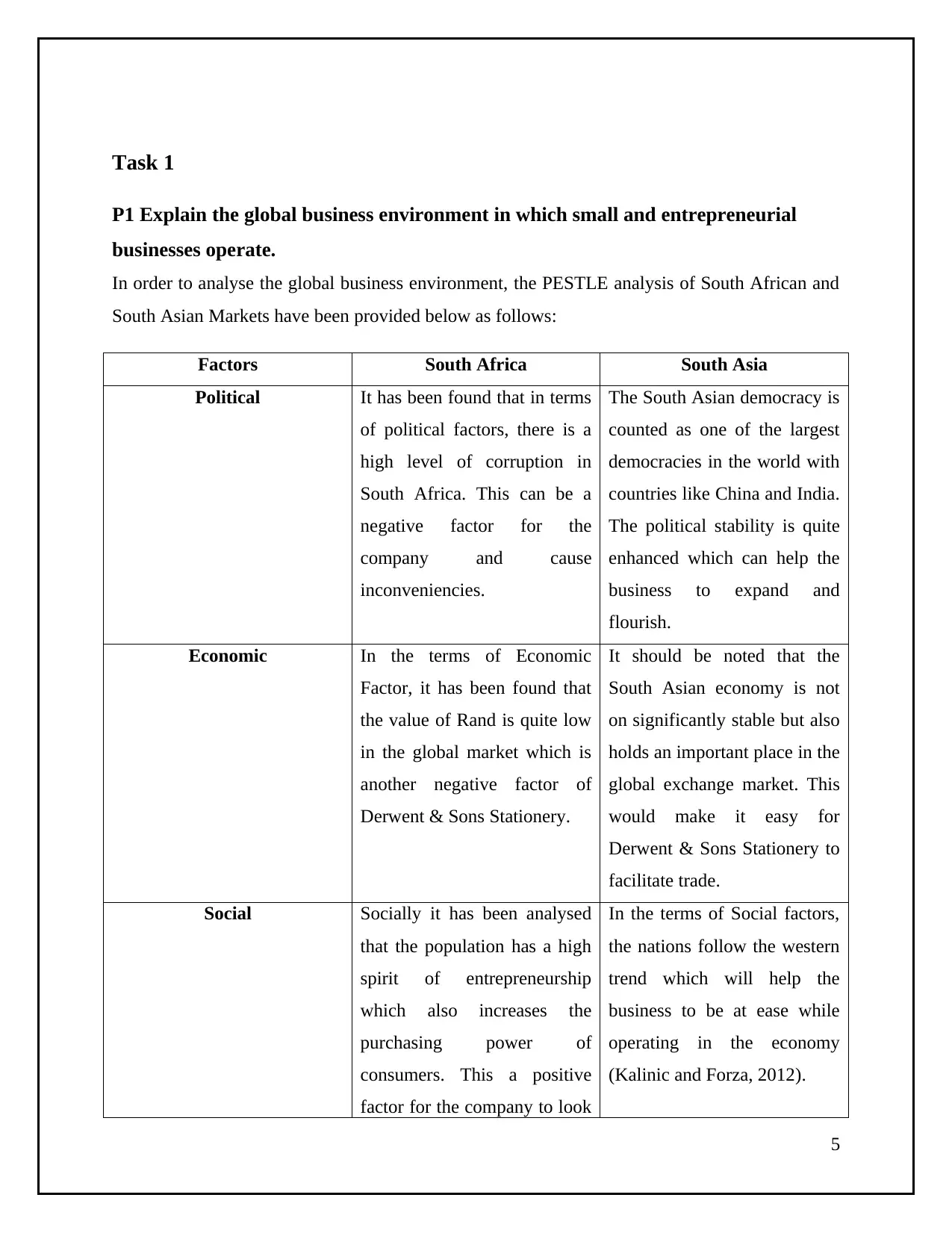
Task 1
P1 Explain the global business environment in which small and entrepreneurial
businesses operate.
In order to analyse the global business environment, the PESTLE analysis of South African and
South Asian Markets have been provided below as follows:
Factors South Africa South Asia
Political It has been found that in terms
of political factors, there is a
high level of corruption in
South Africa. This can be a
negative factor for the
company and cause
inconveniencies.
The South Asian democracy is
counted as one of the largest
democracies in the world with
countries like China and India.
The political stability is quite
enhanced which can help the
business to expand and
flourish.
Economic In the terms of Economic
Factor, it has been found that
the value of Rand is quite low
in the global market which is
another negative factor of
Derwent & Sons Stationery.
It should be noted that the
South Asian economy is not
on significantly stable but also
holds an important place in the
global exchange market. This
would make it easy for
Derwent & Sons Stationery to
facilitate trade.
Social Socially it has been analysed
that the population has a high
spirit of entrepreneurship
which also increases the
purchasing power of
consumers. This a positive
factor for the company to look
In the terms of Social factors,
the nations follow the western
trend which will help the
business to be at ease while
operating in the economy
(Kalinic and Forza, 2012).
5
P1 Explain the global business environment in which small and entrepreneurial
businesses operate.
In order to analyse the global business environment, the PESTLE analysis of South African and
South Asian Markets have been provided below as follows:
Factors South Africa South Asia
Political It has been found that in terms
of political factors, there is a
high level of corruption in
South Africa. This can be a
negative factor for the
company and cause
inconveniencies.
The South Asian democracy is
counted as one of the largest
democracies in the world with
countries like China and India.
The political stability is quite
enhanced which can help the
business to expand and
flourish.
Economic In the terms of Economic
Factor, it has been found that
the value of Rand is quite low
in the global market which is
another negative factor of
Derwent & Sons Stationery.
It should be noted that the
South Asian economy is not
on significantly stable but also
holds an important place in the
global exchange market. This
would make it easy for
Derwent & Sons Stationery to
facilitate trade.
Social Socially it has been analysed
that the population has a high
spirit of entrepreneurship
which also increases the
purchasing power of
consumers. This a positive
factor for the company to look
In the terms of Social factors,
the nations follow the western
trend which will help the
business to be at ease while
operating in the economy
(Kalinic and Forza, 2012).
5
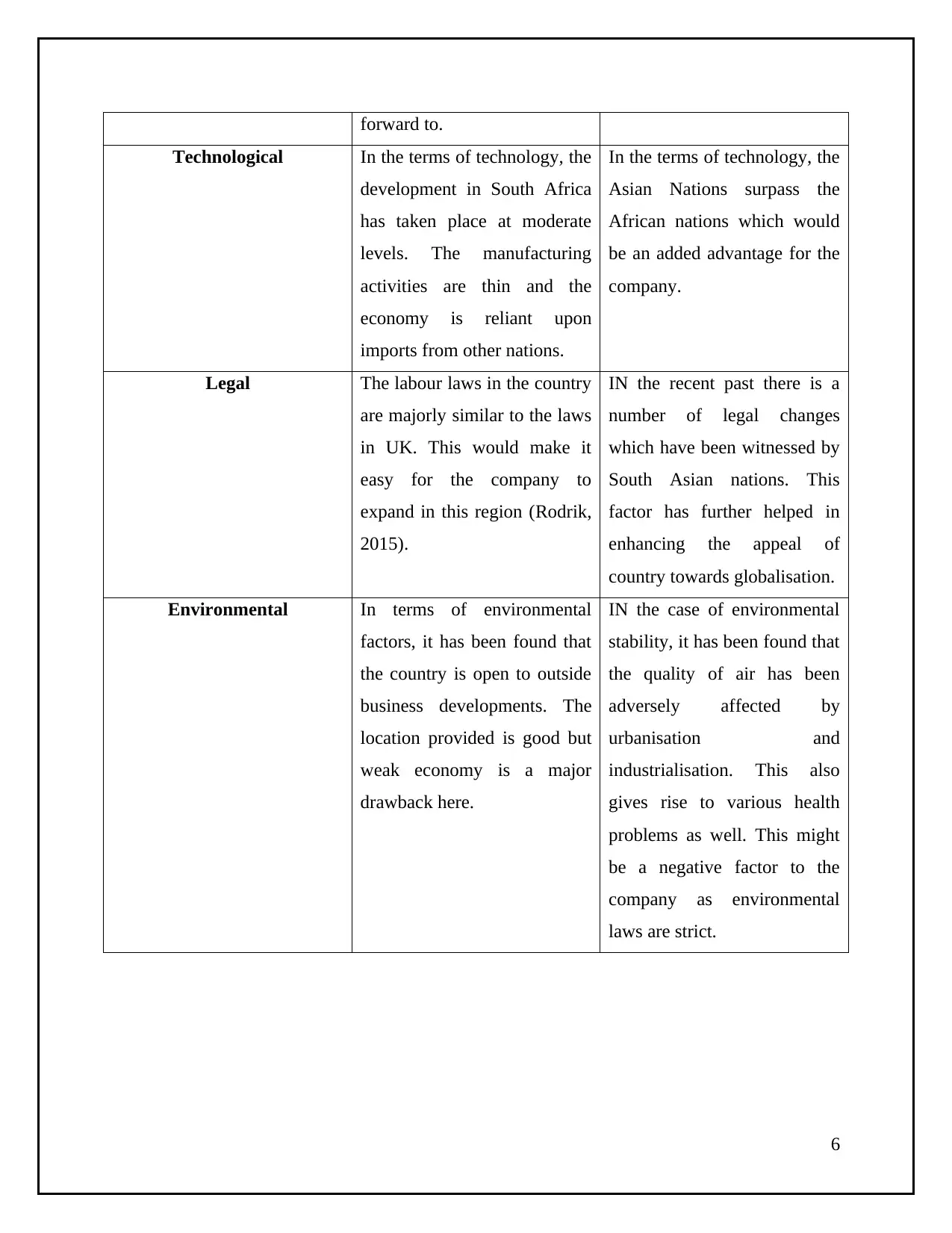
forward to.
Technological In the terms of technology, the
development in South Africa
has taken place at moderate
levels. The manufacturing
activities are thin and the
economy is reliant upon
imports from other nations.
In the terms of technology, the
Asian Nations surpass the
African nations which would
be an added advantage for the
company.
Legal The labour laws in the country
are majorly similar to the laws
in UK. This would make it
easy for the company to
expand in this region (Rodrik,
2015).
IN the recent past there is a
number of legal changes
which have been witnessed by
South Asian nations. This
factor has further helped in
enhancing the appeal of
country towards globalisation.
Environmental In terms of environmental
factors, it has been found that
the country is open to outside
business developments. The
location provided is good but
weak economy is a major
drawback here.
IN the case of environmental
stability, it has been found that
the quality of air has been
adversely affected by
urbanisation and
industrialisation. This also
gives rise to various health
problems as well. This might
be a negative factor to the
company as environmental
laws are strict.
6
Technological In the terms of technology, the
development in South Africa
has taken place at moderate
levels. The manufacturing
activities are thin and the
economy is reliant upon
imports from other nations.
In the terms of technology, the
Asian Nations surpass the
African nations which would
be an added advantage for the
company.
Legal The labour laws in the country
are majorly similar to the laws
in UK. This would make it
easy for the company to
expand in this region (Rodrik,
2015).
IN the recent past there is a
number of legal changes
which have been witnessed by
South Asian nations. This
factor has further helped in
enhancing the appeal of
country towards globalisation.
Environmental In terms of environmental
factors, it has been found that
the country is open to outside
business developments. The
location provided is good but
weak economy is a major
drawback here.
IN the case of environmental
stability, it has been found that
the quality of air has been
adversely affected by
urbanisation and
industrialisation. This also
gives rise to various health
problems as well. This might
be a negative factor to the
company as environmental
laws are strict.
6
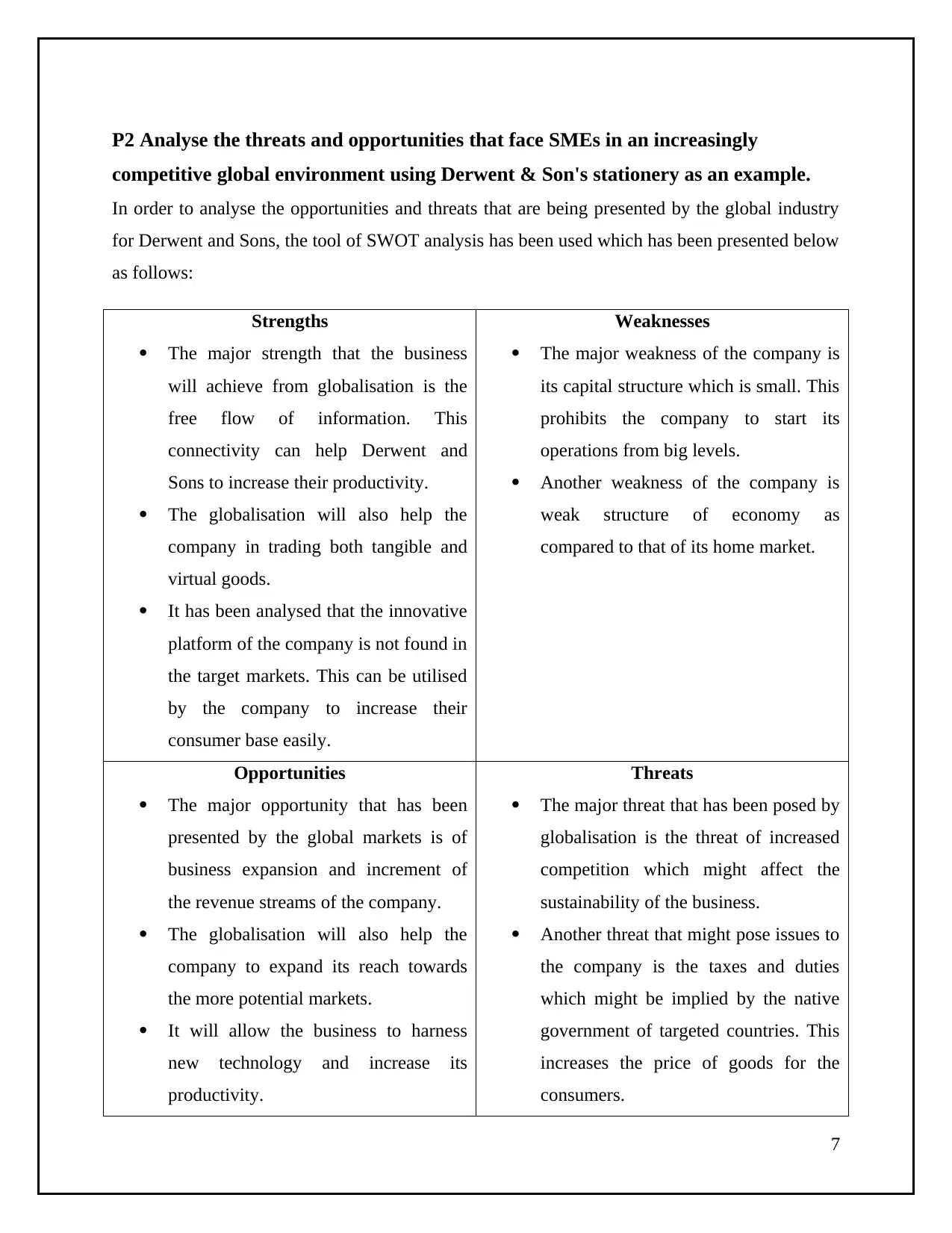
P2 Analyse the threats and opportunities that face SMEs in an increasingly
competitive global environment using Derwent & Son's stationery as an example.
In order to analyse the opportunities and threats that are being presented by the global industry
for Derwent and Sons, the tool of SWOT analysis has been used which has been presented below
as follows:
Strengths
The major strength that the business
will achieve from globalisation is the
free flow of information. This
connectivity can help Derwent and
Sons to increase their productivity.
The globalisation will also help the
company in trading both tangible and
virtual goods.
It has been analysed that the innovative
platform of the company is not found in
the target markets. This can be utilised
by the company to increase their
consumer base easily.
Weaknesses
The major weakness of the company is
its capital structure which is small. This
prohibits the company to start its
operations from big levels.
Another weakness of the company is
weak structure of economy as
compared to that of its home market.
Opportunities
The major opportunity that has been
presented by the global markets is of
business expansion and increment of
the revenue streams of the company.
The globalisation will also help the
company to expand its reach towards
the more potential markets.
It will allow the business to harness
new technology and increase its
productivity.
Threats
The major threat that has been posed by
globalisation is the threat of increased
competition which might affect the
sustainability of the business.
Another threat that might pose issues to
the company is the taxes and duties
which might be implied by the native
government of targeted countries. This
increases the price of goods for the
consumers.
7
competitive global environment using Derwent & Son's stationery as an example.
In order to analyse the opportunities and threats that are being presented by the global industry
for Derwent and Sons, the tool of SWOT analysis has been used which has been presented below
as follows:
Strengths
The major strength that the business
will achieve from globalisation is the
free flow of information. This
connectivity can help Derwent and
Sons to increase their productivity.
The globalisation will also help the
company in trading both tangible and
virtual goods.
It has been analysed that the innovative
platform of the company is not found in
the target markets. This can be utilised
by the company to increase their
consumer base easily.
Weaknesses
The major weakness of the company is
its capital structure which is small. This
prohibits the company to start its
operations from big levels.
Another weakness of the company is
weak structure of economy as
compared to that of its home market.
Opportunities
The major opportunity that has been
presented by the global markets is of
business expansion and increment of
the revenue streams of the company.
The globalisation will also help the
company to expand its reach towards
the more potential markets.
It will allow the business to harness
new technology and increase its
productivity.
Threats
The major threat that has been posed by
globalisation is the threat of increased
competition which might affect the
sustainability of the business.
Another threat that might pose issues to
the company is the taxes and duties
which might be implied by the native
government of targeted countries. This
increases the price of goods for the
consumers.
7
Paraphrase This Document
Need a fresh take? Get an instant paraphrase of this document with our AI Paraphraser
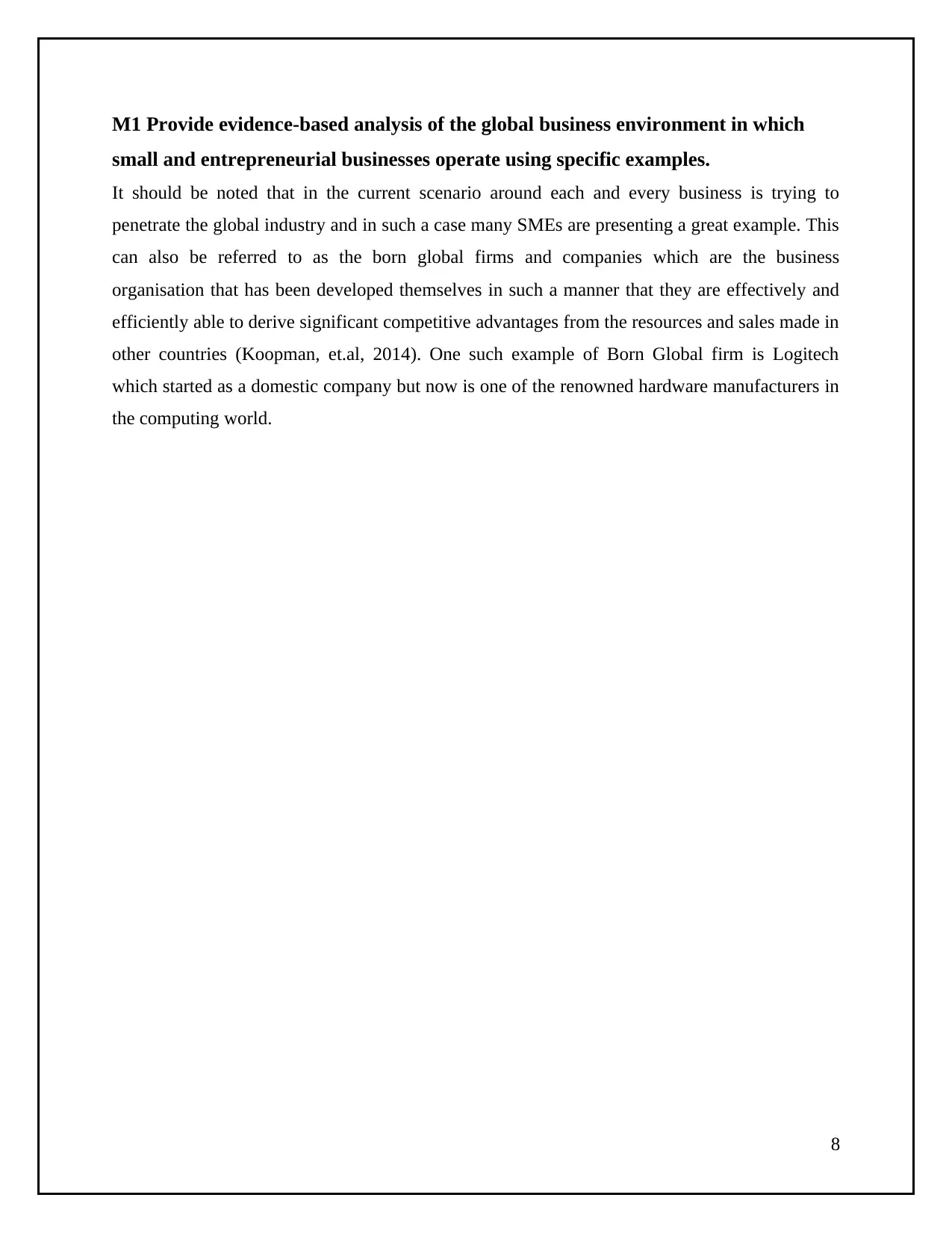
M1 Provide evidence-based analysis of the global business environment in which
small and entrepreneurial businesses operate using specific examples.
It should be noted that in the current scenario around each and every business is trying to
penetrate the global industry and in such a case many SMEs are presenting a great example. This
can also be referred to as the born global firms and companies which are the business
organisation that has been developed themselves in such a manner that they are effectively and
efficiently able to derive significant competitive advantages from the resources and sales made in
other countries (Koopman, et.al, 2014). One such example of Born Global firm is Logitech
which started as a domestic company but now is one of the renowned hardware manufacturers in
the computing world.
8
small and entrepreneurial businesses operate using specific examples.
It should be noted that in the current scenario around each and every business is trying to
penetrate the global industry and in such a case many SMEs are presenting a great example. This
can also be referred to as the born global firms and companies which are the business
organisation that has been developed themselves in such a manner that they are effectively and
efficiently able to derive significant competitive advantages from the resources and sales made in
other countries (Koopman, et.al, 2014). One such example of Born Global firm is Logitech
which started as a domestic company but now is one of the renowned hardware manufacturers in
the computing world.
8
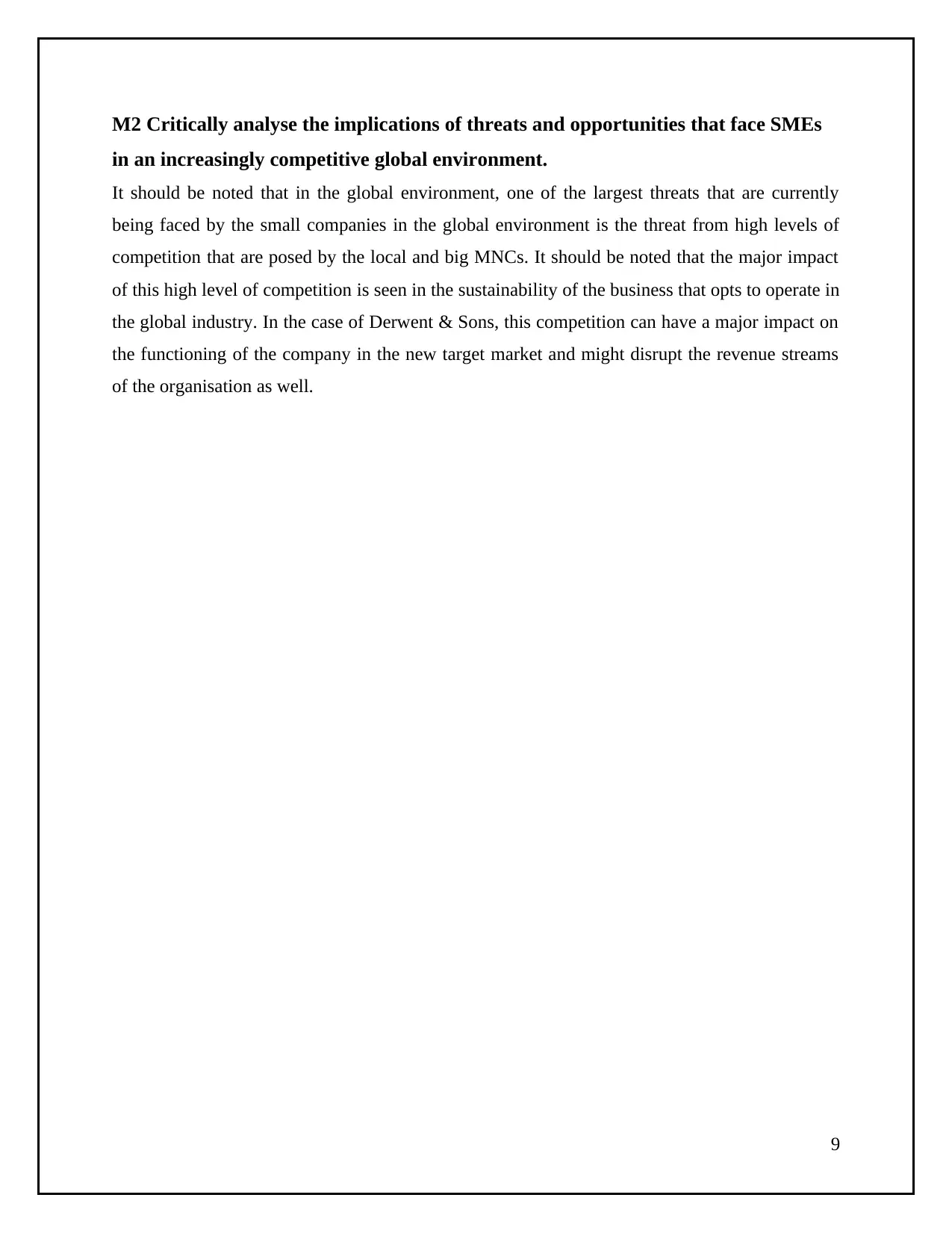
M2 Critically analyse the implications of threats and opportunities that face SMEs
in an increasingly competitive global environment.
It should be noted that in the global environment, one of the largest threats that are currently
being faced by the small companies in the global environment is the threat from high levels of
competition that are posed by the local and big MNCs. It should be noted that the major impact
of this high level of competition is seen in the sustainability of the business that opts to operate in
the global industry. In the case of Derwent & Sons, this competition can have a major impact on
the functioning of the company in the new target market and might disrupt the revenue streams
of the organisation as well.
9
in an increasingly competitive global environment.
It should be noted that in the global environment, one of the largest threats that are currently
being faced by the small companies in the global environment is the threat from high levels of
competition that are posed by the local and big MNCs. It should be noted that the major impact
of this high level of competition is seen in the sustainability of the business that opts to operate in
the global industry. In the case of Derwent & Sons, this competition can have a major impact on
the functioning of the company in the new target market and might disrupt the revenue streams
of the organisation as well.
9
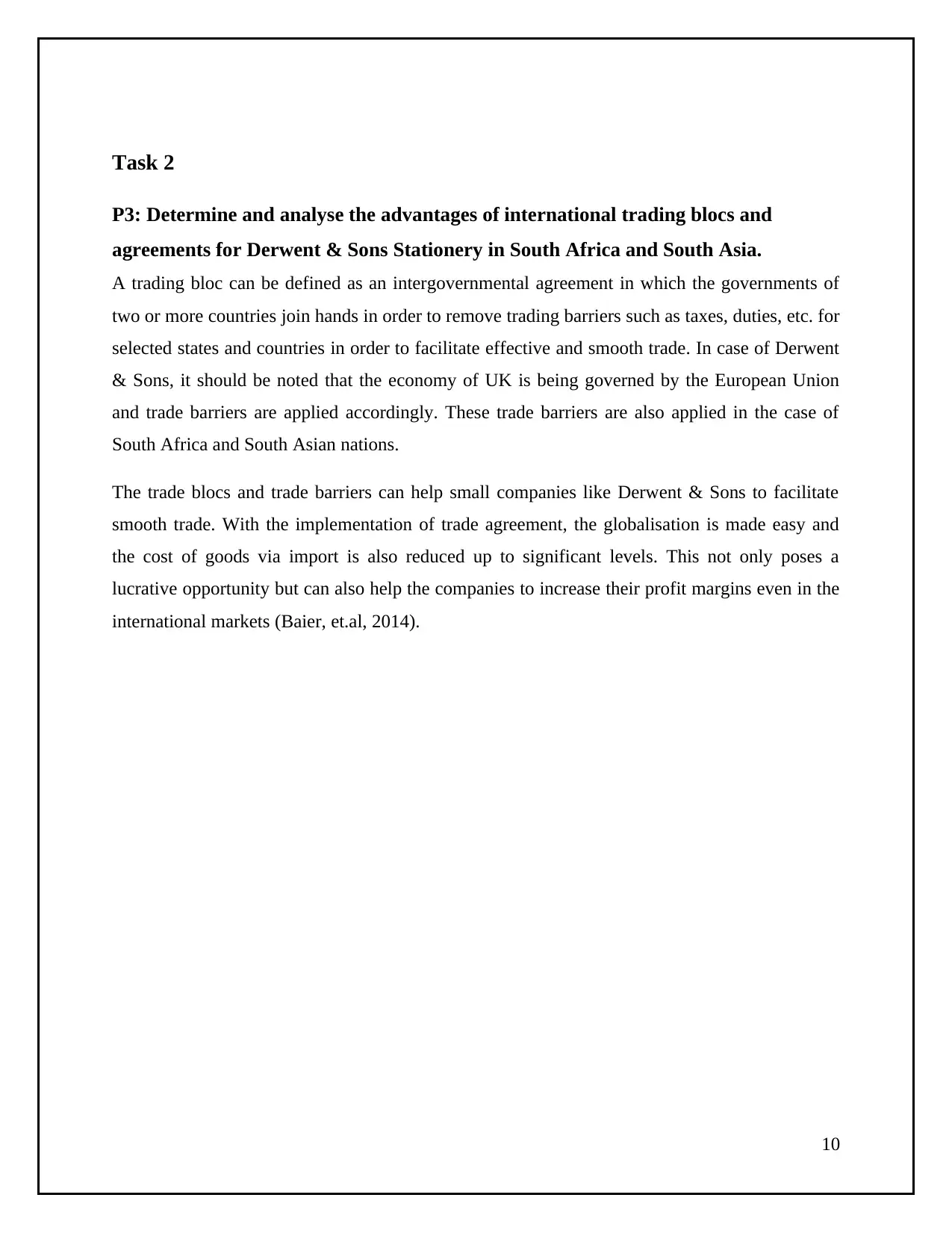
Task 2
P3: Determine and analyse the advantages of international trading blocs and
agreements for Derwent & Sons Stationery in South Africa and South Asia.
A trading bloc can be defined as an intergovernmental agreement in which the governments of
two or more countries join hands in order to remove trading barriers such as taxes, duties, etc. for
selected states and countries in order to facilitate effective and smooth trade. In case of Derwent
& Sons, it should be noted that the economy of UK is being governed by the European Union
and trade barriers are applied accordingly. These trade barriers are also applied in the case of
South Africa and South Asian nations.
The trade blocs and trade barriers can help small companies like Derwent & Sons to facilitate
smooth trade. With the implementation of trade agreement, the globalisation is made easy and
the cost of goods via import is also reduced up to significant levels. This not only poses a
lucrative opportunity but can also help the companies to increase their profit margins even in the
international markets (Baier, et.al, 2014).
10
P3: Determine and analyse the advantages of international trading blocs and
agreements for Derwent & Sons Stationery in South Africa and South Asia.
A trading bloc can be defined as an intergovernmental agreement in which the governments of
two or more countries join hands in order to remove trading barriers such as taxes, duties, etc. for
selected states and countries in order to facilitate effective and smooth trade. In case of Derwent
& Sons, it should be noted that the economy of UK is being governed by the European Union
and trade barriers are applied accordingly. These trade barriers are also applied in the case of
South Africa and South Asian nations.
The trade blocs and trade barriers can help small companies like Derwent & Sons to facilitate
smooth trade. With the implementation of trade agreement, the globalisation is made easy and
the cost of goods via import is also reduced up to significant levels. This not only poses a
lucrative opportunity but can also help the companies to increase their profit margins even in the
international markets (Baier, et.al, 2014).
10
Secure Best Marks with AI Grader
Need help grading? Try our AI Grader for instant feedback on your assignments.
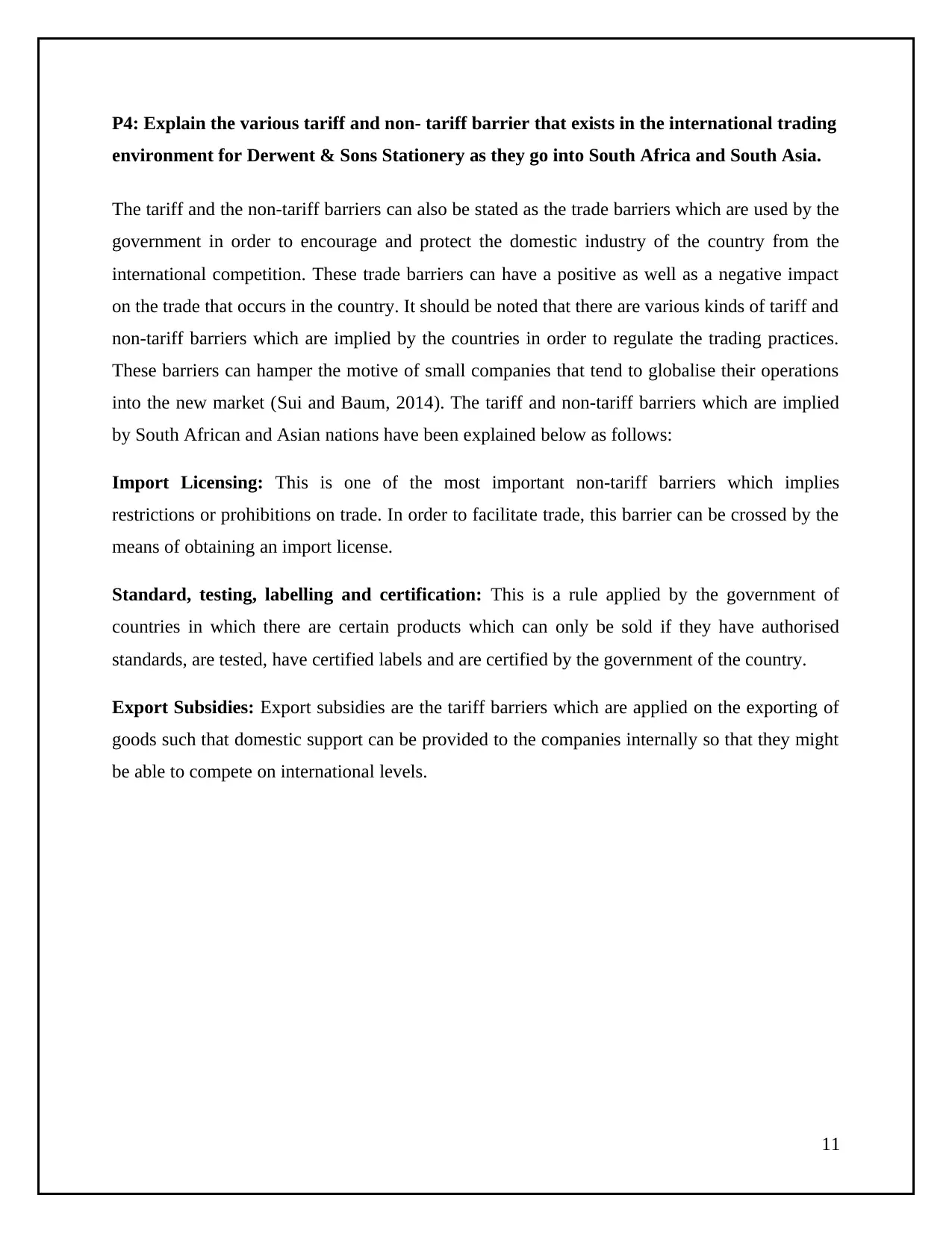
P4: Explain the various tariff and non- tariff barrier that exists in the international trading
environment for Derwent & Sons Stationery as they go into South Africa and South Asia.
The tariff and the non-tariff barriers can also be stated as the trade barriers which are used by the
government in order to encourage and protect the domestic industry of the country from the
international competition. These trade barriers can have a positive as well as a negative impact
on the trade that occurs in the country. It should be noted that there are various kinds of tariff and
non-tariff barriers which are implied by the countries in order to regulate the trading practices.
These barriers can hamper the motive of small companies that tend to globalise their operations
into the new market (Sui and Baum, 2014). The tariff and non-tariff barriers which are implied
by South African and Asian nations have been explained below as follows:
Import Licensing: This is one of the most important non-tariff barriers which implies
restrictions or prohibitions on trade. In order to facilitate trade, this barrier can be crossed by the
means of obtaining an import license.
Standard, testing, labelling and certification: This is a rule applied by the government of
countries in which there are certain products which can only be sold if they have authorised
standards, are tested, have certified labels and are certified by the government of the country.
Export Subsidies: Export subsidies are the tariff barriers which are applied on the exporting of
goods such that domestic support can be provided to the companies internally so that they might
be able to compete on international levels.
11
environment for Derwent & Sons Stationery as they go into South Africa and South Asia.
The tariff and the non-tariff barriers can also be stated as the trade barriers which are used by the
government in order to encourage and protect the domestic industry of the country from the
international competition. These trade barriers can have a positive as well as a negative impact
on the trade that occurs in the country. It should be noted that there are various kinds of tariff and
non-tariff barriers which are implied by the countries in order to regulate the trading practices.
These barriers can hamper the motive of small companies that tend to globalise their operations
into the new market (Sui and Baum, 2014). The tariff and non-tariff barriers which are implied
by South African and Asian nations have been explained below as follows:
Import Licensing: This is one of the most important non-tariff barriers which implies
restrictions or prohibitions on trade. In order to facilitate trade, this barrier can be crossed by the
means of obtaining an import license.
Standard, testing, labelling and certification: This is a rule applied by the government of
countries in which there are certain products which can only be sold if they have authorised
standards, are tested, have certified labels and are certified by the government of the country.
Export Subsidies: Export subsidies are the tariff barriers which are applied on the exporting of
goods such that domestic support can be provided to the companies internally so that they might
be able to compete on international levels.
11

M3: Evaluate the advantages of international trading blocs and agreements and their
implications for SMEs Using Derwent and Sons Stationery as an example.
Usually at regional level, sovereign countries club together in order to make free trade
agreements. Free trade agreements lower down the barriers in bilateral trade and trigger the trade
between the two member nations. For Derwent and Sons Stationery, it is a golden opportunity
to expand its business. Generally, trade agreements overcast positive effects on the business, but
many a times it gives birth to competition from the other country. Trading blocs are groups of
nations that agree to lower down the trade barriers among the members. The benefits include
tariff reduction, tax reduction, trading privileges, etc.
12
implications for SMEs Using Derwent and Sons Stationery as an example.
Usually at regional level, sovereign countries club together in order to make free trade
agreements. Free trade agreements lower down the barriers in bilateral trade and trigger the trade
between the two member nations. For Derwent and Sons Stationery, it is a golden opportunity
to expand its business. Generally, trade agreements overcast positive effects on the business, but
many a times it gives birth to competition from the other country. Trading blocs are groups of
nations that agree to lower down the trade barriers among the members. The benefits include
tariff reduction, tax reduction, trading privileges, etc.
12
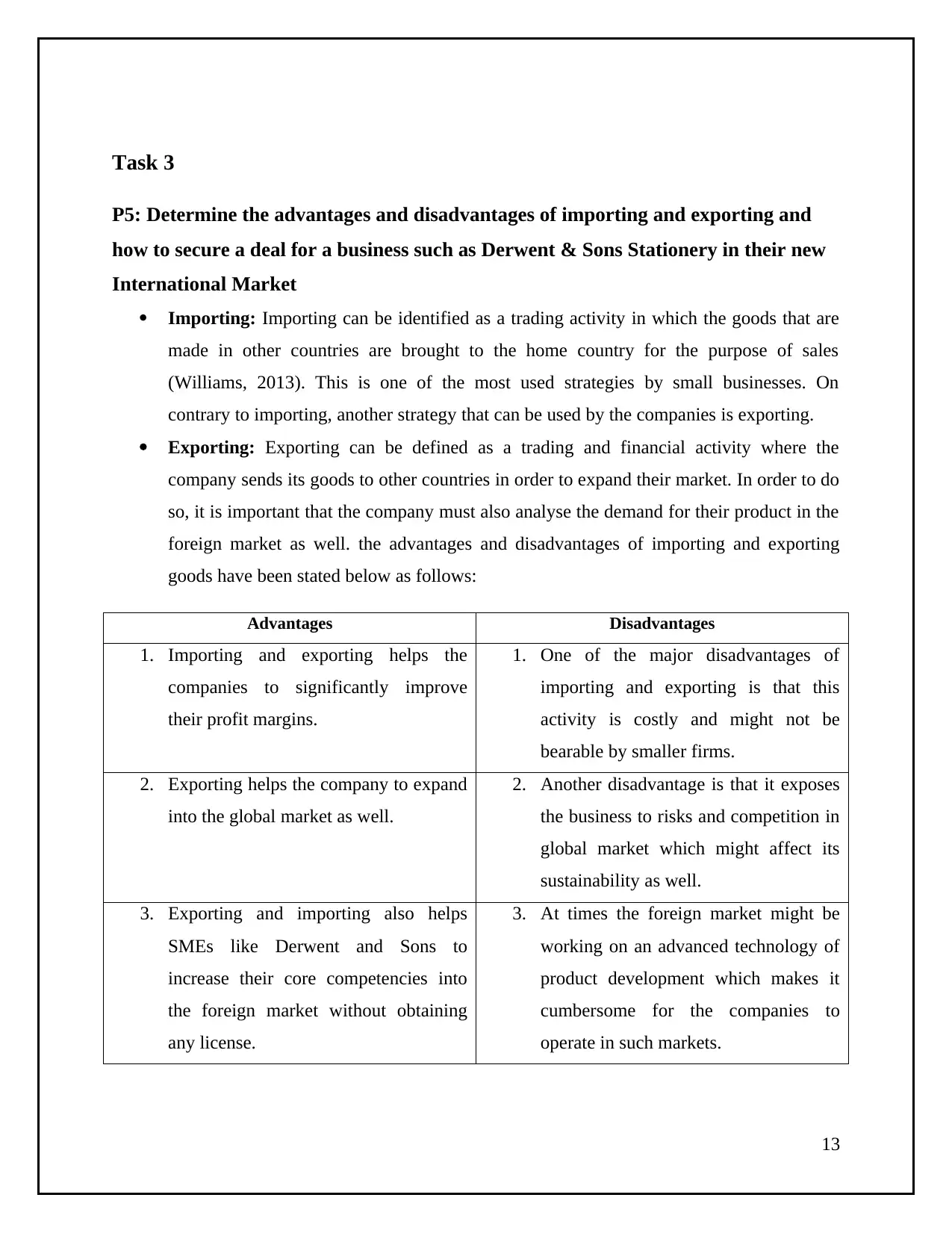
Task 3
P5: Determine the advantages and disadvantages of importing and exporting and
how to secure a deal for a business such as Derwent & Sons Stationery in their new
International Market
Importing: Importing can be identified as a trading activity in which the goods that are
made in other countries are brought to the home country for the purpose of sales
(Williams, 2013). This is one of the most used strategies by small businesses. On
contrary to importing, another strategy that can be used by the companies is exporting.
Exporting: Exporting can be defined as a trading and financial activity where the
company sends its goods to other countries in order to expand their market. In order to do
so, it is important that the company must also analyse the demand for their product in the
foreign market as well. the advantages and disadvantages of importing and exporting
goods have been stated below as follows:
Advantages Disadvantages
1. Importing and exporting helps the
companies to significantly improve
their profit margins.
1. One of the major disadvantages of
importing and exporting is that this
activity is costly and might not be
bearable by smaller firms.
2. Exporting helps the company to expand
into the global market as well.
2. Another disadvantage is that it exposes
the business to risks and competition in
global market which might affect its
sustainability as well.
3. Exporting and importing also helps
SMEs like Derwent and Sons to
increase their core competencies into
the foreign market without obtaining
any license.
3. At times the foreign market might be
working on an advanced technology of
product development which makes it
cumbersome for the companies to
operate in such markets.
13
P5: Determine the advantages and disadvantages of importing and exporting and
how to secure a deal for a business such as Derwent & Sons Stationery in their new
International Market
Importing: Importing can be identified as a trading activity in which the goods that are
made in other countries are brought to the home country for the purpose of sales
(Williams, 2013). This is one of the most used strategies by small businesses. On
contrary to importing, another strategy that can be used by the companies is exporting.
Exporting: Exporting can be defined as a trading and financial activity where the
company sends its goods to other countries in order to expand their market. In order to do
so, it is important that the company must also analyse the demand for their product in the
foreign market as well. the advantages and disadvantages of importing and exporting
goods have been stated below as follows:
Advantages Disadvantages
1. Importing and exporting helps the
companies to significantly improve
their profit margins.
1. One of the major disadvantages of
importing and exporting is that this
activity is costly and might not be
bearable by smaller firms.
2. Exporting helps the company to expand
into the global market as well.
2. Another disadvantage is that it exposes
the business to risks and competition in
global market which might affect its
sustainability as well.
3. Exporting and importing also helps
SMEs like Derwent and Sons to
increase their core competencies into
the foreign market without obtaining
any license.
3. At times the foreign market might be
working on an advanced technology of
product development which makes it
cumbersome for the companies to
operate in such markets.
13
Paraphrase This Document
Need a fresh take? Get an instant paraphrase of this document with our AI Paraphraser
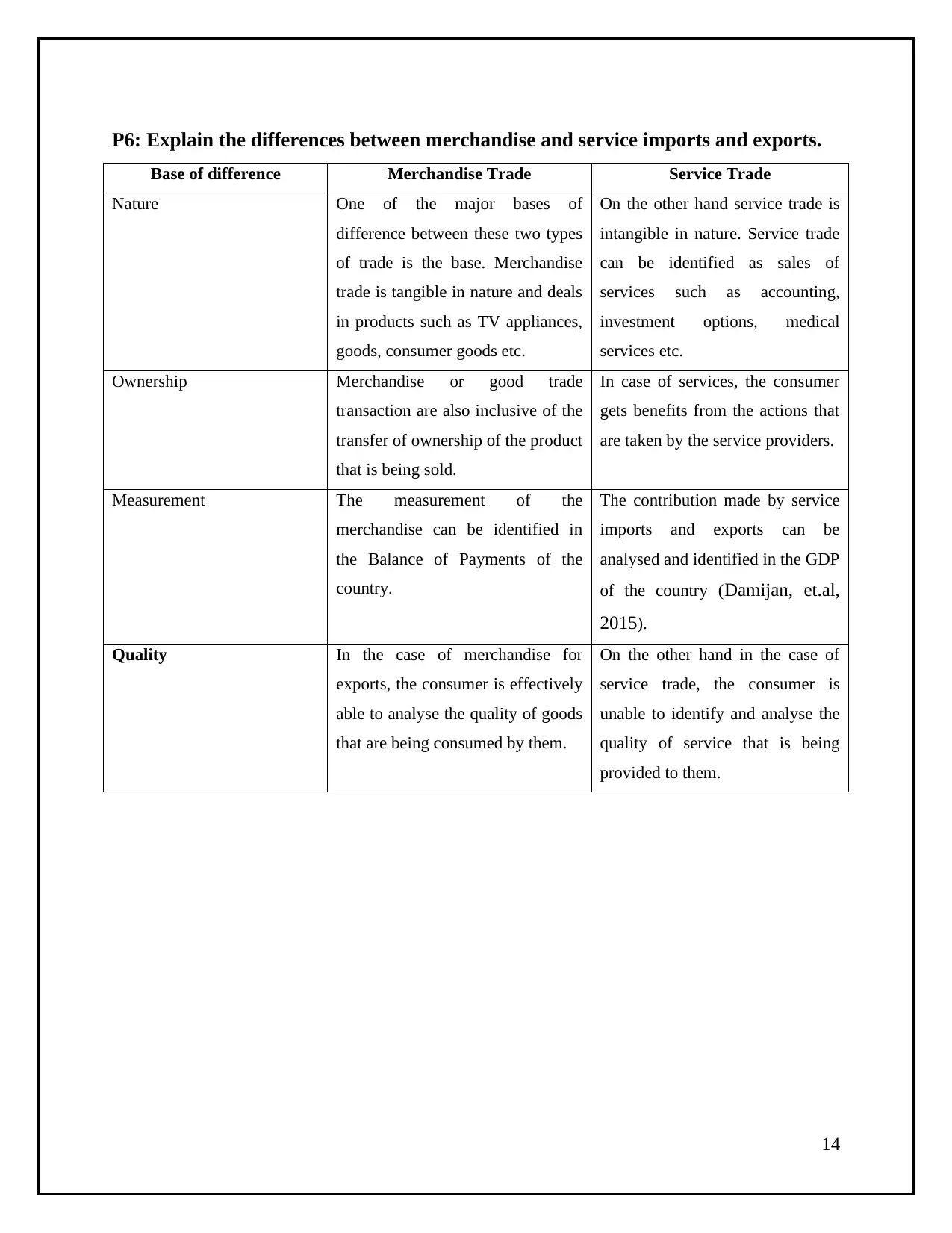
P6: Explain the differences between merchandise and service imports and exports.
Base of difference Merchandise Trade Service Trade
Nature One of the major bases of
difference between these two types
of trade is the base. Merchandise
trade is tangible in nature and deals
in products such as TV appliances,
goods, consumer goods etc.
On the other hand service trade is
intangible in nature. Service trade
can be identified as sales of
services such as accounting,
investment options, medical
services etc.
Ownership Merchandise or good trade
transaction are also inclusive of the
transfer of ownership of the product
that is being sold.
In case of services, the consumer
gets benefits from the actions that
are taken by the service providers.
Measurement The measurement of the
merchandise can be identified in
the Balance of Payments of the
country.
The contribution made by service
imports and exports can be
analysed and identified in the GDP
of the country (Damijan, et.al,
2015).
Quality In the case of merchandise for
exports, the consumer is effectively
able to analyse the quality of goods
that are being consumed by them.
On the other hand in the case of
service trade, the consumer is
unable to identify and analyse the
quality of service that is being
provided to them.
14
Base of difference Merchandise Trade Service Trade
Nature One of the major bases of
difference between these two types
of trade is the base. Merchandise
trade is tangible in nature and deals
in products such as TV appliances,
goods, consumer goods etc.
On the other hand service trade is
intangible in nature. Service trade
can be identified as sales of
services such as accounting,
investment options, medical
services etc.
Ownership Merchandise or good trade
transaction are also inclusive of the
transfer of ownership of the product
that is being sold.
In case of services, the consumer
gets benefits from the actions that
are taken by the service providers.
Measurement The measurement of the
merchandise can be identified in
the Balance of Payments of the
country.
The contribution made by service
imports and exports can be
analysed and identified in the GDP
of the country (Damijan, et.al,
2015).
Quality In the case of merchandise for
exports, the consumer is effectively
able to analyse the quality of goods
that are being consumed by them.
On the other hand in the case of
service trade, the consumer is
unable to identify and analyse the
quality of service that is being
provided to them.
14
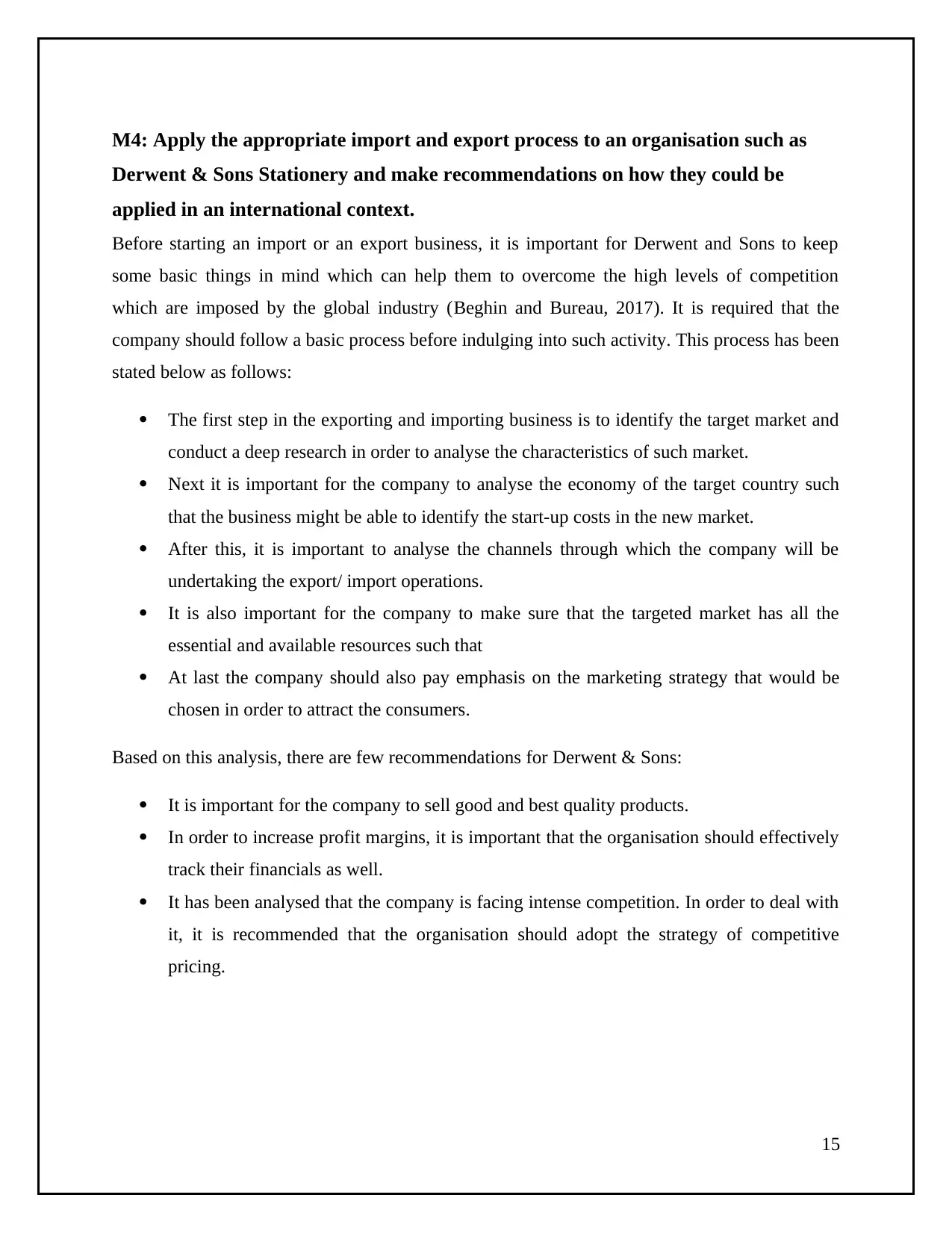
M4: Apply the appropriate import and export process to an organisation such as
Derwent & Sons Stationery and make recommendations on how they could be
applied in an international context.
Before starting an import or an export business, it is important for Derwent and Sons to keep
some basic things in mind which can help them to overcome the high levels of competition
which are imposed by the global industry (Beghin and Bureau, 2017). It is required that the
company should follow a basic process before indulging into such activity. This process has been
stated below as follows:
The first step in the exporting and importing business is to identify the target market and
conduct a deep research in order to analyse the characteristics of such market.
Next it is important for the company to analyse the economy of the target country such
that the business might be able to identify the start-up costs in the new market.
After this, it is important to analyse the channels through which the company will be
undertaking the export/ import operations.
It is also important for the company to make sure that the targeted market has all the
essential and available resources such that
At last the company should also pay emphasis on the marketing strategy that would be
chosen in order to attract the consumers.
Based on this analysis, there are few recommendations for Derwent & Sons:
It is important for the company to sell good and best quality products.
In order to increase profit margins, it is important that the organisation should effectively
track their financials as well.
It has been analysed that the company is facing intense competition. In order to deal with
it, it is recommended that the organisation should adopt the strategy of competitive
pricing.
15
Derwent & Sons Stationery and make recommendations on how they could be
applied in an international context.
Before starting an import or an export business, it is important for Derwent and Sons to keep
some basic things in mind which can help them to overcome the high levels of competition
which are imposed by the global industry (Beghin and Bureau, 2017). It is required that the
company should follow a basic process before indulging into such activity. This process has been
stated below as follows:
The first step in the exporting and importing business is to identify the target market and
conduct a deep research in order to analyse the characteristics of such market.
Next it is important for the company to analyse the economy of the target country such
that the business might be able to identify the start-up costs in the new market.
After this, it is important to analyse the channels through which the company will be
undertaking the export/ import operations.
It is also important for the company to make sure that the targeted market has all the
essential and available resources such that
At last the company should also pay emphasis on the marketing strategy that would be
chosen in order to attract the consumers.
Based on this analysis, there are few recommendations for Derwent & Sons:
It is important for the company to sell good and best quality products.
In order to increase profit margins, it is important that the organisation should effectively
track their financials as well.
It has been analysed that the company is facing intense competition. In order to deal with
it, it is recommended that the organisation should adopt the strategy of competitive
pricing.
15
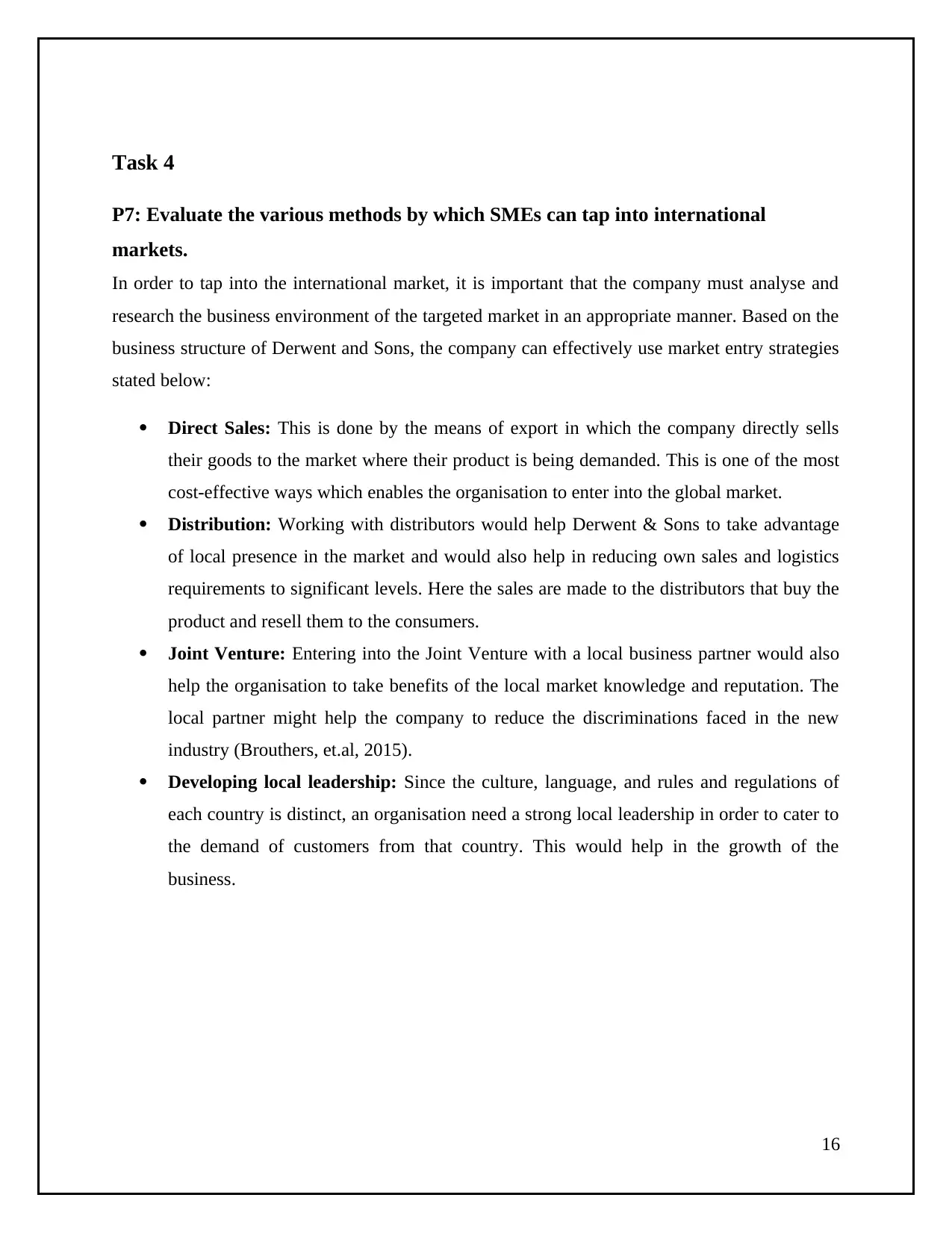
Task 4
P7: Evaluate the various methods by which SMEs can tap into international
markets.
In order to tap into the international market, it is important that the company must analyse and
research the business environment of the targeted market in an appropriate manner. Based on the
business structure of Derwent and Sons, the company can effectively use market entry strategies
stated below:
Direct Sales: This is done by the means of export in which the company directly sells
their goods to the market where their product is being demanded. This is one of the most
cost-effective ways which enables the organisation to enter into the global market.
Distribution: Working with distributors would help Derwent & Sons to take advantage
of local presence in the market and would also help in reducing own sales and logistics
requirements to significant levels. Here the sales are made to the distributors that buy the
product and resell them to the consumers.
Joint Venture: Entering into the Joint Venture with a local business partner would also
help the organisation to take benefits of the local market knowledge and reputation. The
local partner might help the company to reduce the discriminations faced in the new
industry (Brouthers, et.al, 2015).
Developing local leadership: Since the culture, language, and rules and regulations of
each country is distinct, an organisation need a strong local leadership in order to cater to
the demand of customers from that country. This would help in the growth of the
business.
16
P7: Evaluate the various methods by which SMEs can tap into international
markets.
In order to tap into the international market, it is important that the company must analyse and
research the business environment of the targeted market in an appropriate manner. Based on the
business structure of Derwent and Sons, the company can effectively use market entry strategies
stated below:
Direct Sales: This is done by the means of export in which the company directly sells
their goods to the market where their product is being demanded. This is one of the most
cost-effective ways which enables the organisation to enter into the global market.
Distribution: Working with distributors would help Derwent & Sons to take advantage
of local presence in the market and would also help in reducing own sales and logistics
requirements to significant levels. Here the sales are made to the distributors that buy the
product and resell them to the consumers.
Joint Venture: Entering into the Joint Venture with a local business partner would also
help the organisation to take benefits of the local market knowledge and reputation. The
local partner might help the company to reduce the discriminations faced in the new
industry (Brouthers, et.al, 2015).
Developing local leadership: Since the culture, language, and rules and regulations of
each country is distinct, an organisation need a strong local leadership in order to cater to
the demand of customers from that country. This would help in the growth of the
business.
16
Secure Best Marks with AI Grader
Need help grading? Try our AI Grader for instant feedback on your assignments.
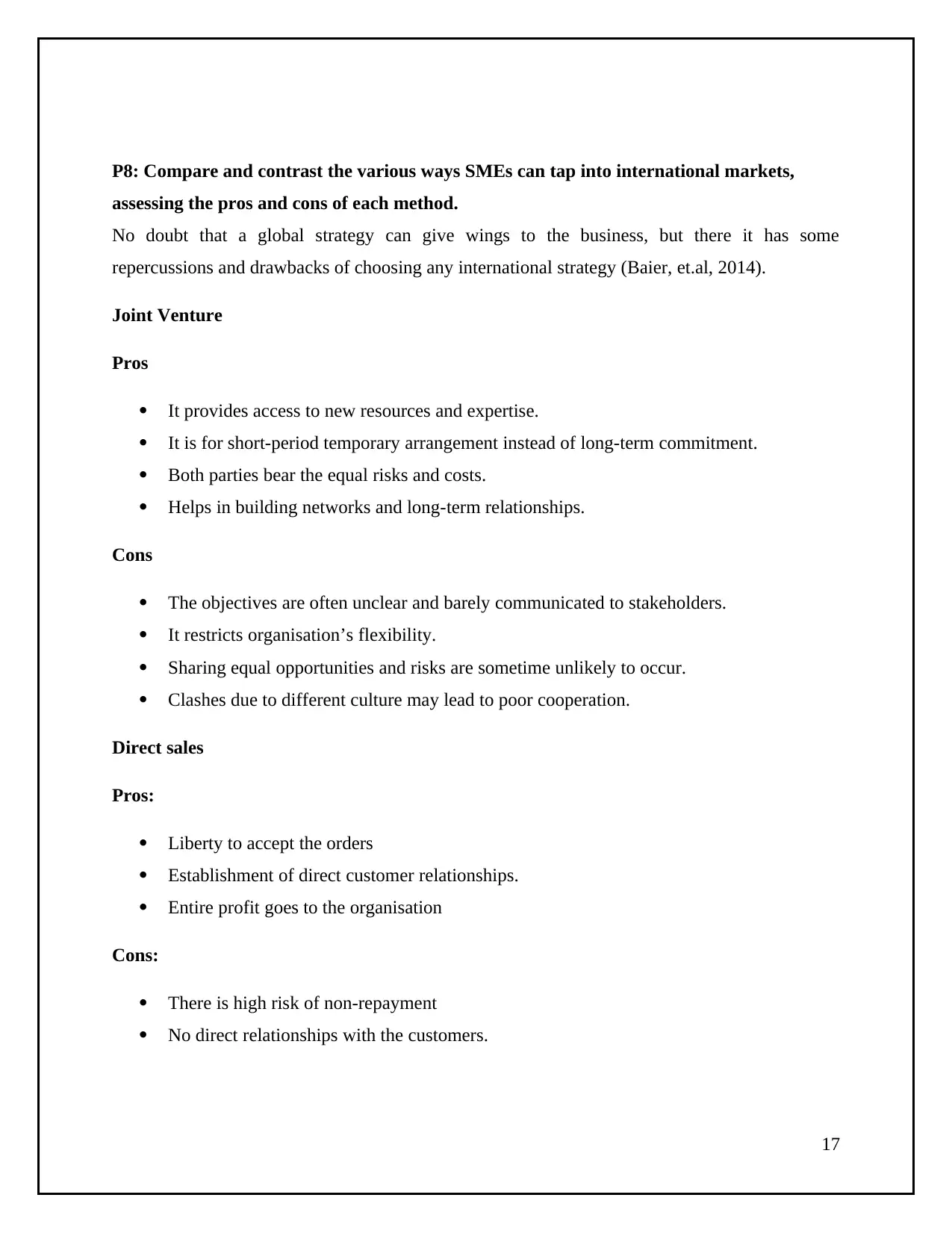
P8: Compare and contrast the various ways SMEs can tap into international markets,
assessing the pros and cons of each method.
No doubt that a global strategy can give wings to the business, but there it has some
repercussions and drawbacks of choosing any international strategy (Baier, et.al, 2014).
Joint Venture
Pros
It provides access to new resources and expertise.
It is for short-period temporary arrangement instead of long-term commitment.
Both parties bear the equal risks and costs.
Helps in building networks and long-term relationships.
Cons
The objectives are often unclear and barely communicated to stakeholders.
It restricts organisation’s flexibility.
Sharing equal opportunities and risks are sometime unlikely to occur.
Clashes due to different culture may lead to poor cooperation.
Direct sales
Pros:
Liberty to accept the orders
Establishment of direct customer relationships.
Entire profit goes to the organisation
Cons:
There is high risk of non-repayment
No direct relationships with the customers.
17
assessing the pros and cons of each method.
No doubt that a global strategy can give wings to the business, but there it has some
repercussions and drawbacks of choosing any international strategy (Baier, et.al, 2014).
Joint Venture
Pros
It provides access to new resources and expertise.
It is for short-period temporary arrangement instead of long-term commitment.
Both parties bear the equal risks and costs.
Helps in building networks and long-term relationships.
Cons
The objectives are often unclear and barely communicated to stakeholders.
It restricts organisation’s flexibility.
Sharing equal opportunities and risks are sometime unlikely to occur.
Clashes due to different culture may lead to poor cooperation.
Direct sales
Pros:
Liberty to accept the orders
Establishment of direct customer relationships.
Entire profit goes to the organisation
Cons:
There is high risk of non-repayment
No direct relationships with the customers.
17
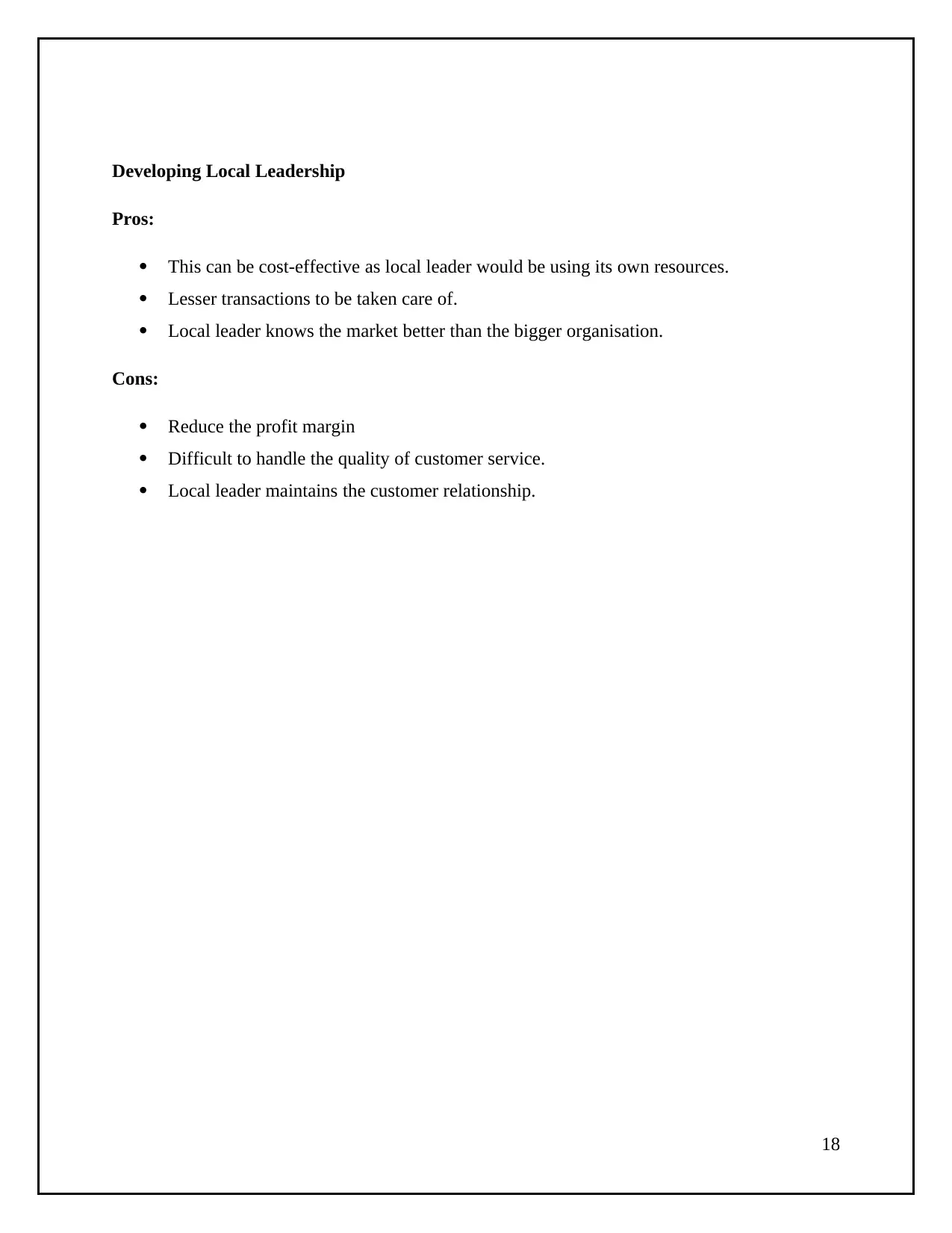
Developing Local Leadership
Pros:
This can be cost-effective as local leader would be using its own resources.
Lesser transactions to be taken care of.
Local leader knows the market better than the bigger organisation.
Cons:
Reduce the profit margin
Difficult to handle the quality of customer service.
Local leader maintains the customer relationship.
18
Pros:
This can be cost-effective as local leader would be using its own resources.
Lesser transactions to be taken care of.
Local leader knows the market better than the bigger organisation.
Cons:
Reduce the profit margin
Difficult to handle the quality of customer service.
Local leader maintains the customer relationship.
18
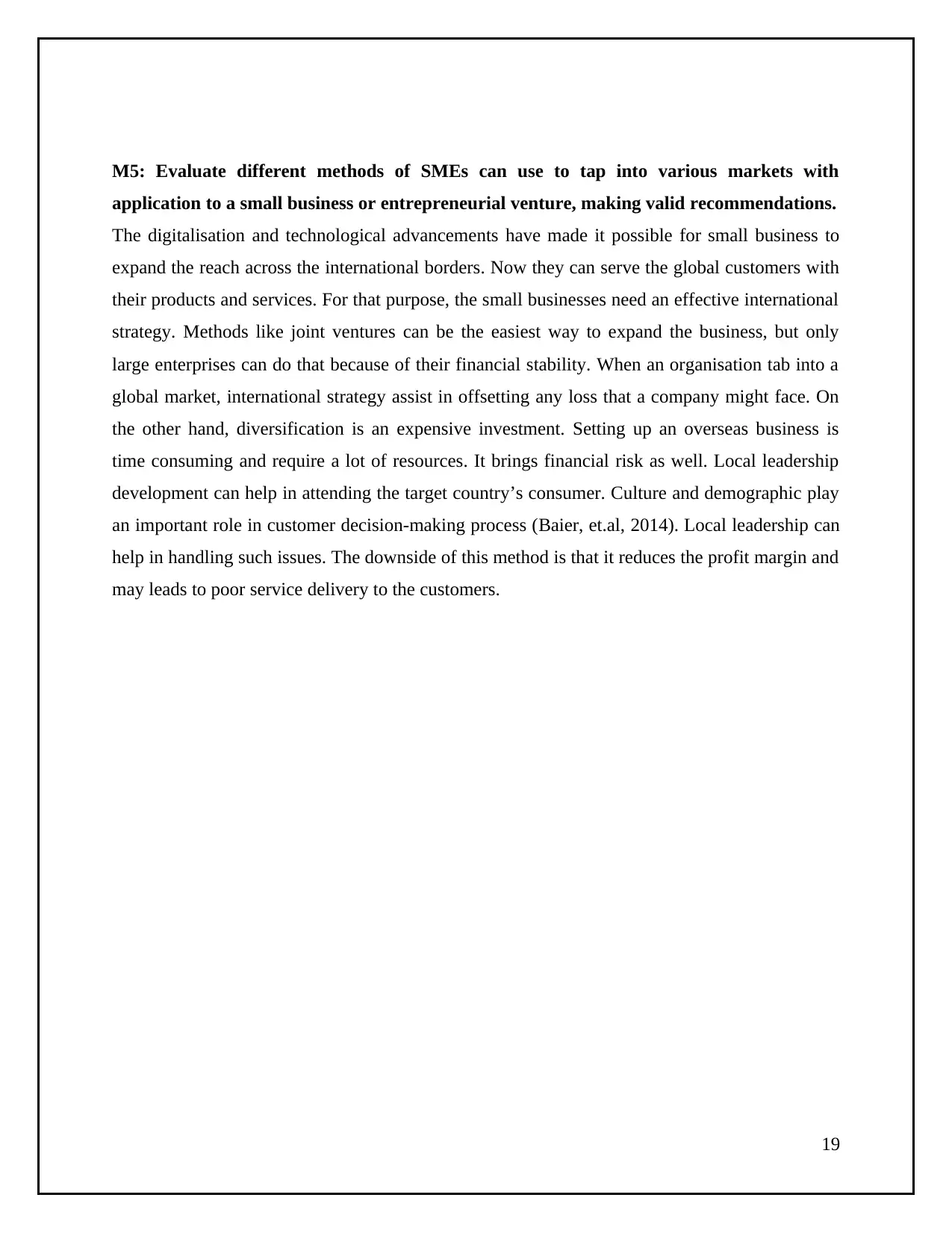
M5: Evaluate different methods of SMEs can use to tap into various markets with
application to a small business or entrepreneurial venture, making valid recommendations.
The digitalisation and technological advancements have made it possible for small business to
expand the reach across the international borders. Now they can serve the global customers with
their products and services. For that purpose, the small businesses need an effective international
strategy. Methods like joint ventures can be the easiest way to expand the business, but only
large enterprises can do that because of their financial stability. When an organisation tab into a
global market, international strategy assist in offsetting any loss that a company might face. On
the other hand, diversification is an expensive investment. Setting up an overseas business is
time consuming and require a lot of resources. It brings financial risk as well. Local leadership
development can help in attending the target country’s consumer. Culture and demographic play
an important role in customer decision-making process (Baier, et.al, 2014). Local leadership can
help in handling such issues. The downside of this method is that it reduces the profit margin and
may leads to poor service delivery to the customers.
19
application to a small business or entrepreneurial venture, making valid recommendations.
The digitalisation and technological advancements have made it possible for small business to
expand the reach across the international borders. Now they can serve the global customers with
their products and services. For that purpose, the small businesses need an effective international
strategy. Methods like joint ventures can be the easiest way to expand the business, but only
large enterprises can do that because of their financial stability. When an organisation tab into a
global market, international strategy assist in offsetting any loss that a company might face. On
the other hand, diversification is an expensive investment. Setting up an overseas business is
time consuming and require a lot of resources. It brings financial risk as well. Local leadership
development can help in attending the target country’s consumer. Culture and demographic play
an important role in customer decision-making process (Baier, et.al, 2014). Local leadership can
help in handling such issues. The downside of this method is that it reduces the profit margin and
may leads to poor service delivery to the customers.
19
Paraphrase This Document
Need a fresh take? Get an instant paraphrase of this document with our AI Paraphraser

20
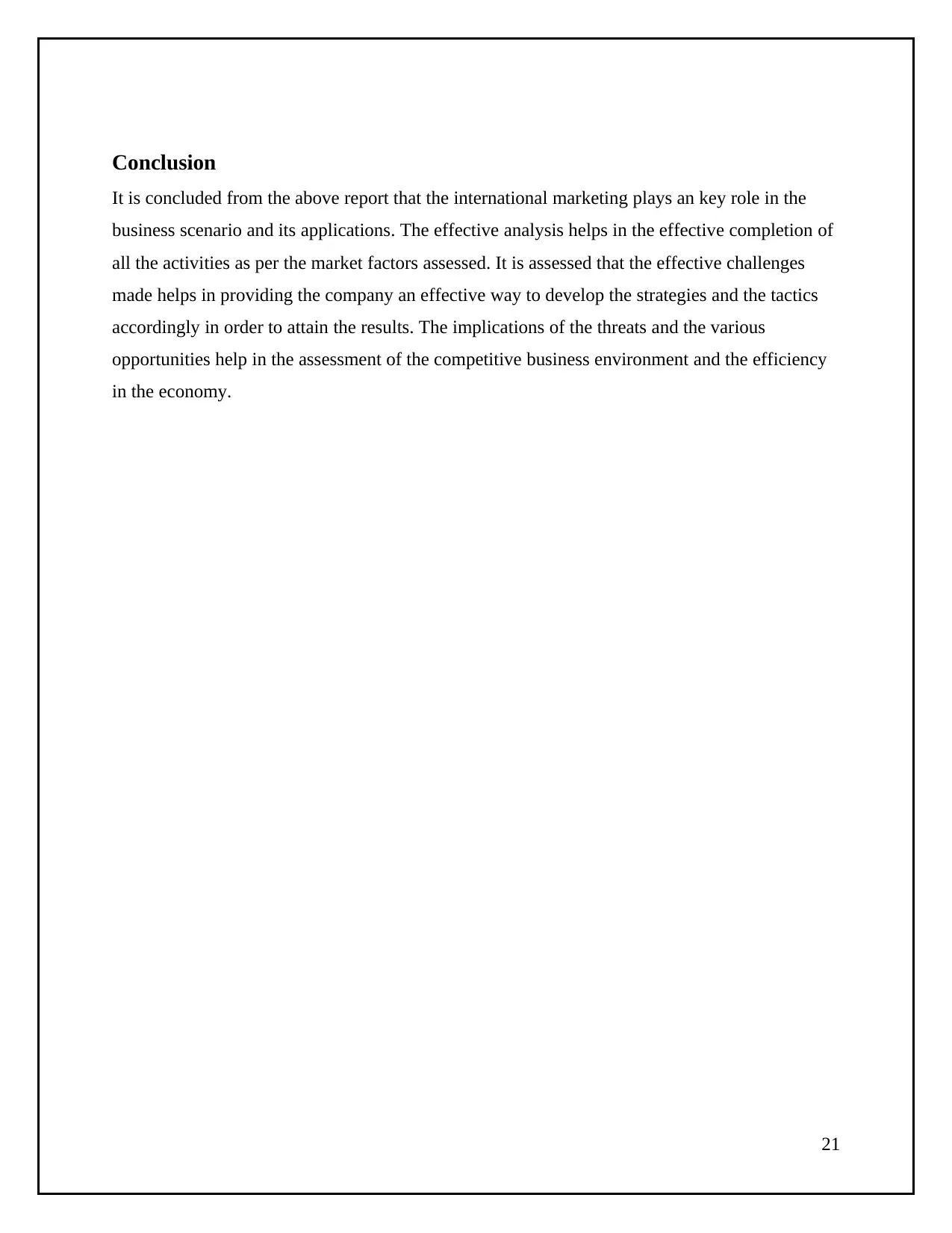
Conclusion
It is concluded from the above report that the international marketing plays an key role in the
business scenario and its applications. The effective analysis helps in the effective completion of
all the activities as per the market factors assessed. It is assessed that the effective challenges
made helps in providing the company an effective way to develop the strategies and the tactics
accordingly in order to attain the results. The implications of the threats and the various
opportunities help in the assessment of the competitive business environment and the efficiency
in the economy.
21
It is concluded from the above report that the international marketing plays an key role in the
business scenario and its applications. The effective analysis helps in the effective completion of
all the activities as per the market factors assessed. It is assessed that the effective challenges
made helps in providing the company an effective way to develop the strategies and the tactics
accordingly in order to attain the results. The implications of the threats and the various
opportunities help in the assessment of the competitive business environment and the efficiency
in the economy.
21
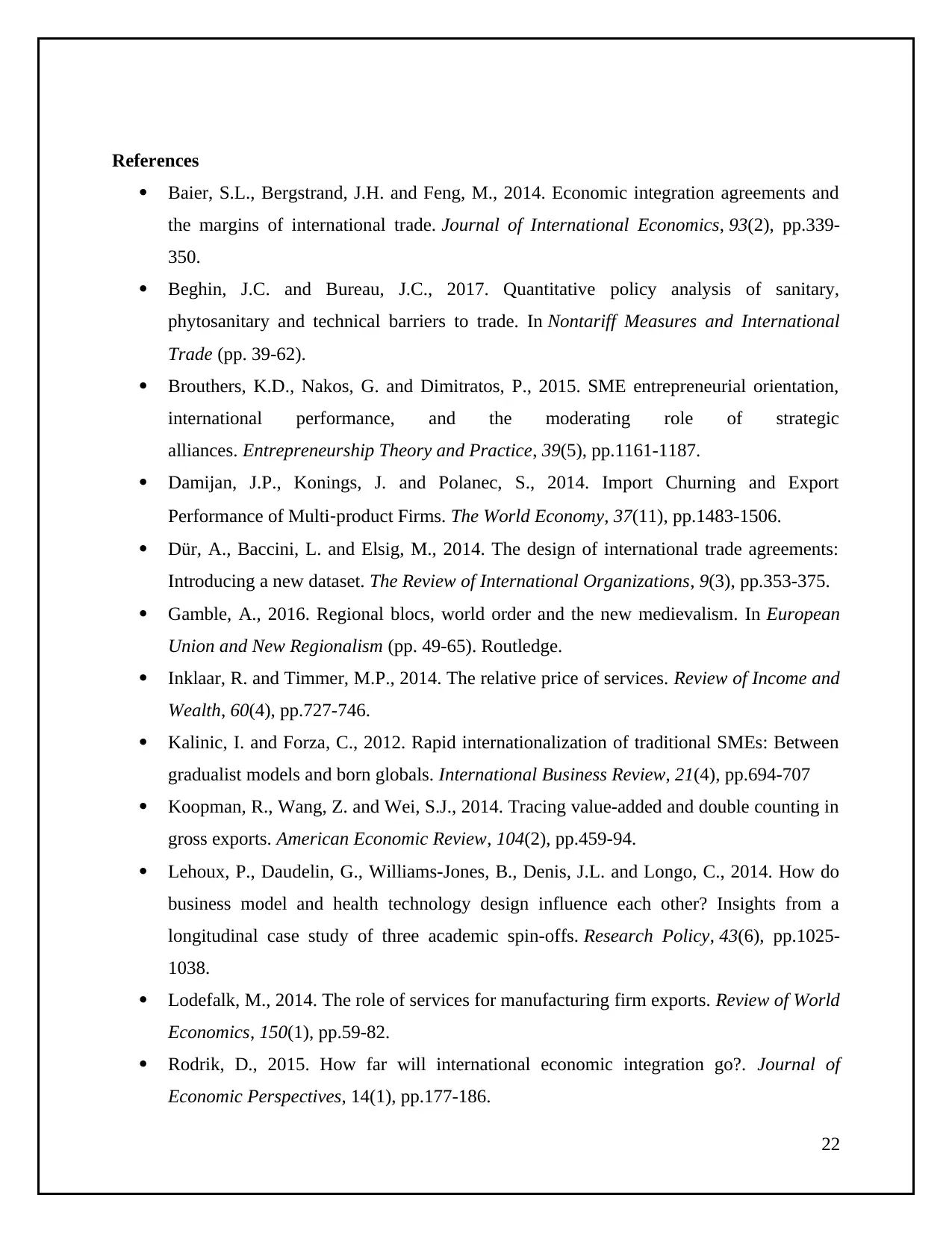
References
Baier, S.L., Bergstrand, J.H. and Feng, M., 2014. Economic integration agreements and
the margins of international trade. Journal of International Economics, 93(2), pp.339-
350.
Beghin, J.C. and Bureau, J.C., 2017. Quantitative policy analysis of sanitary,
phytosanitary and technical barriers to trade. In Nontariff Measures and International
Trade (pp. 39-62).
Brouthers, K.D., Nakos, G. and Dimitratos, P., 2015. SME entrepreneurial orientation,
international performance, and the moderating role of strategic
alliances. Entrepreneurship Theory and Practice, 39(5), pp.1161-1187.
Damijan, J.P., Konings, J. and Polanec, S., 2014. Import Churning and Export
Performance of Multi‐product Firms. The World Economy, 37(11), pp.1483-1506.
Dür, A., Baccini, L. and Elsig, M., 2014. The design of international trade agreements:
Introducing a new dataset. The Review of International Organizations, 9(3), pp.353-375.
Gamble, A., 2016. Regional blocs, world order and the new medievalism. In European
Union and New Regionalism (pp. 49-65). Routledge.
Inklaar, R. and Timmer, M.P., 2014. The relative price of services. Review of Income and
Wealth, 60(4), pp.727-746.
Kalinic, I. and Forza, C., 2012. Rapid internationalization of traditional SMEs: Between
gradualist models and born globals. International Business Review, 21(4), pp.694-707
Koopman, R., Wang, Z. and Wei, S.J., 2014. Tracing value-added and double counting in
gross exports. American Economic Review, 104(2), pp.459-94.
Lehoux, P., Daudelin, G., Williams-Jones, B., Denis, J.L. and Longo, C., 2014. How do
business model and health technology design influence each other? Insights from a
longitudinal case study of three academic spin-offs. Research Policy, 43(6), pp.1025-
1038.
Lodefalk, M., 2014. The role of services for manufacturing firm exports. Review of World
Economics, 150(1), pp.59-82.
Rodrik, D., 2015. How far will international economic integration go?. Journal of
Economic Perspectives, 14(1), pp.177-186.
22
Baier, S.L., Bergstrand, J.H. and Feng, M., 2014. Economic integration agreements and
the margins of international trade. Journal of International Economics, 93(2), pp.339-
350.
Beghin, J.C. and Bureau, J.C., 2017. Quantitative policy analysis of sanitary,
phytosanitary and technical barriers to trade. In Nontariff Measures and International
Trade (pp. 39-62).
Brouthers, K.D., Nakos, G. and Dimitratos, P., 2015. SME entrepreneurial orientation,
international performance, and the moderating role of strategic
alliances. Entrepreneurship Theory and Practice, 39(5), pp.1161-1187.
Damijan, J.P., Konings, J. and Polanec, S., 2014. Import Churning and Export
Performance of Multi‐product Firms. The World Economy, 37(11), pp.1483-1506.
Dür, A., Baccini, L. and Elsig, M., 2014. The design of international trade agreements:
Introducing a new dataset. The Review of International Organizations, 9(3), pp.353-375.
Gamble, A., 2016. Regional blocs, world order and the new medievalism. In European
Union and New Regionalism (pp. 49-65). Routledge.
Inklaar, R. and Timmer, M.P., 2014. The relative price of services. Review of Income and
Wealth, 60(4), pp.727-746.
Kalinic, I. and Forza, C., 2012. Rapid internationalization of traditional SMEs: Between
gradualist models and born globals. International Business Review, 21(4), pp.694-707
Koopman, R., Wang, Z. and Wei, S.J., 2014. Tracing value-added and double counting in
gross exports. American Economic Review, 104(2), pp.459-94.
Lehoux, P., Daudelin, G., Williams-Jones, B., Denis, J.L. and Longo, C., 2014. How do
business model and health technology design influence each other? Insights from a
longitudinal case study of three academic spin-offs. Research Policy, 43(6), pp.1025-
1038.
Lodefalk, M., 2014. The role of services for manufacturing firm exports. Review of World
Economics, 150(1), pp.59-82.
Rodrik, D., 2015. How far will international economic integration go?. Journal of
Economic Perspectives, 14(1), pp.177-186.
22
Secure Best Marks with AI Grader
Need help grading? Try our AI Grader for instant feedback on your assignments.
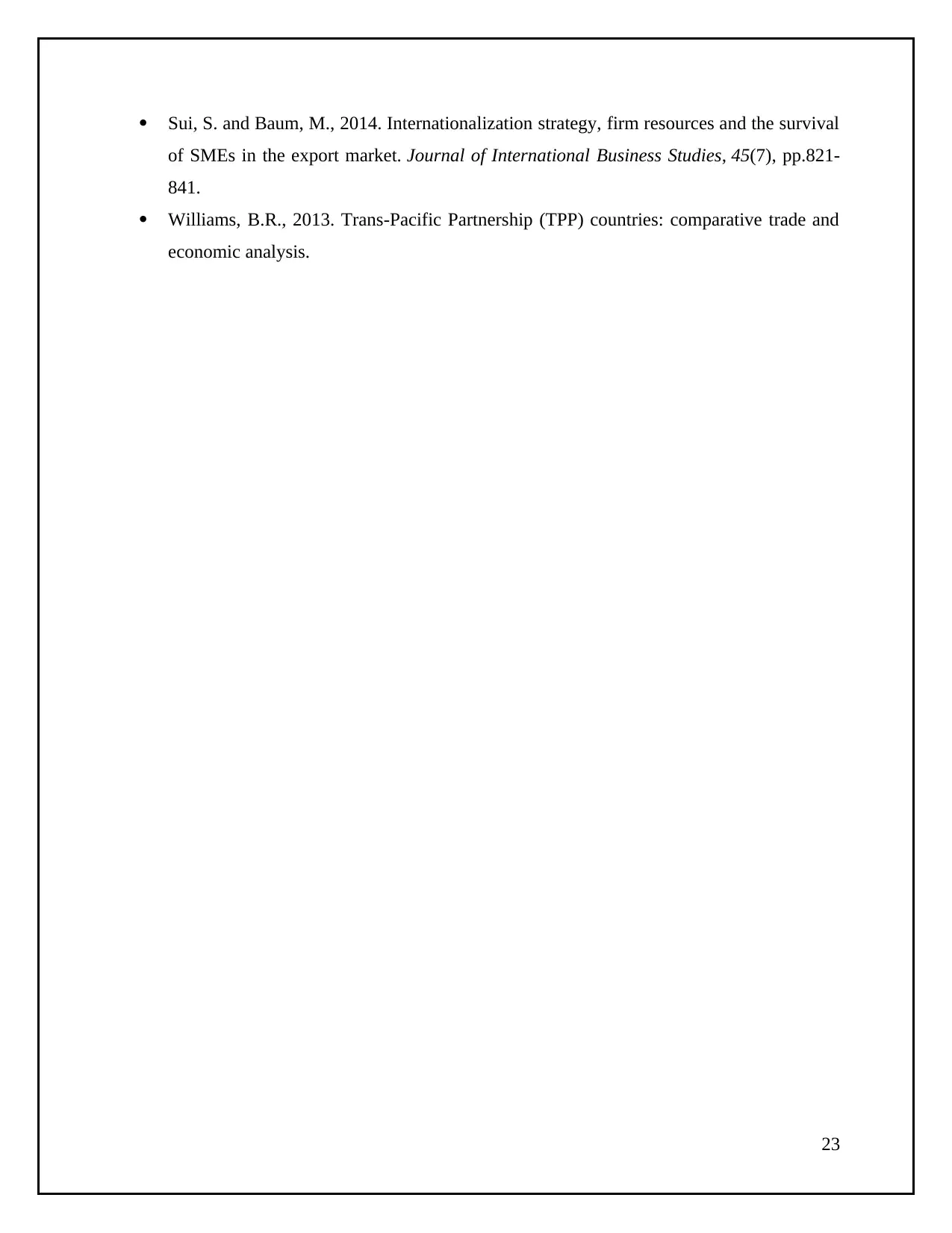
Sui, S. and Baum, M., 2014. Internationalization strategy, firm resources and the survival
of SMEs in the export market. Journal of International Business Studies, 45(7), pp.821-
841.
Williams, B.R., 2013. Trans-Pacific Partnership (TPP) countries: comparative trade and
economic analysis.
23
of SMEs in the export market. Journal of International Business Studies, 45(7), pp.821-
841.
Williams, B.R., 2013. Trans-Pacific Partnership (TPP) countries: comparative trade and
economic analysis.
23
1 out of 23
Related Documents
Your All-in-One AI-Powered Toolkit for Academic Success.
+13062052269
info@desklib.com
Available 24*7 on WhatsApp / Email
![[object Object]](/_next/static/media/star-bottom.7253800d.svg)
Unlock your academic potential
© 2024 | Zucol Services PVT LTD | All rights reserved.





